Hello again everyone. Things here in Iraq are still going well. In fact, this week, I had the opportunity to tag along with some Army engineers.
One difference between Air Force and Army engineers is that the Army engineers use explosives to breech doors, or in this case to bring entire buildings down. It worked out as a great joint training opportunity. The Army conducted their training and we in the Air Force provided support. I was there as an observer and to help coordinate Air Force support. The overall goal was to use a number of small charges to teach what damage different types of charges cause and to eventually completely destroy the building. It was a condemned facility that we no longer needed.
Here’s what the building looked like at the beginning (remember what it looks like here … it won’t stay this way very long).
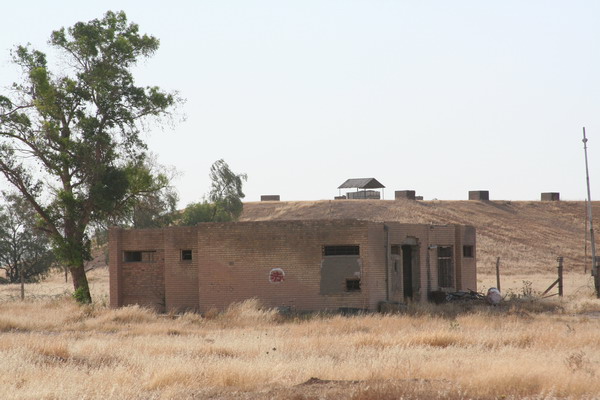
As most male children will agree, it’s fun to watch things go boom. Here is the first of the day.
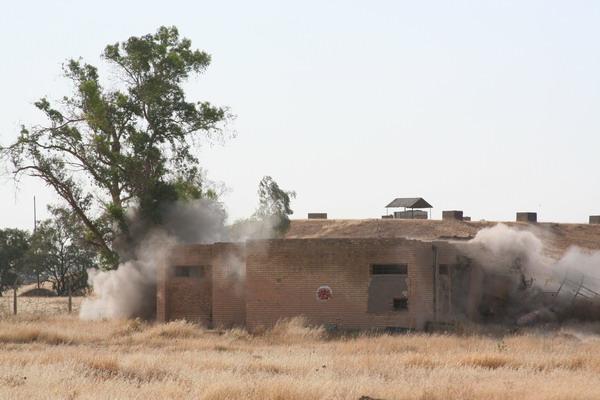
This is the damage that the explosive charge and the over-pressure caused by the explosion wreaked on the building from that first blast.
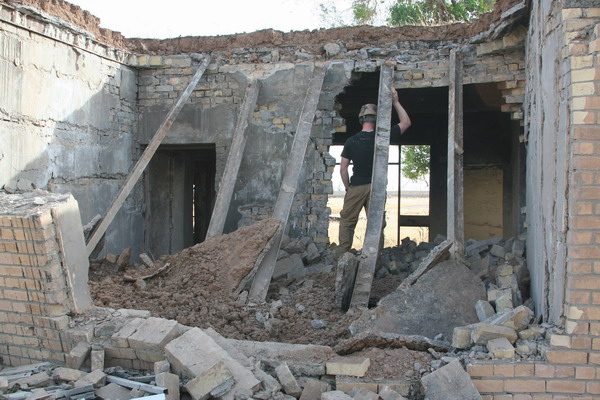
This is a perfect example of what a breaching hole looks like. The idea is to use an explosive charge only large enough to create a man-sized hole to enter through, not bring the whole building down.
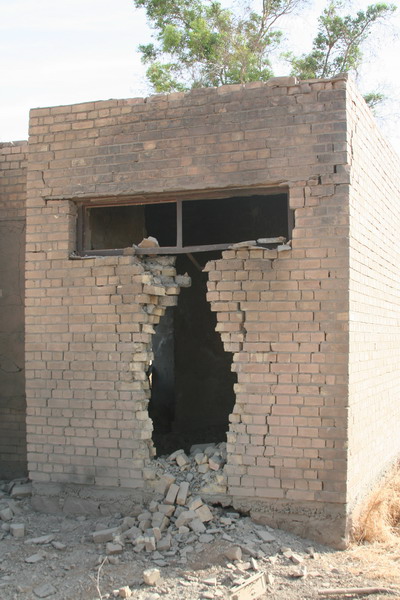
Here is another charge being built.
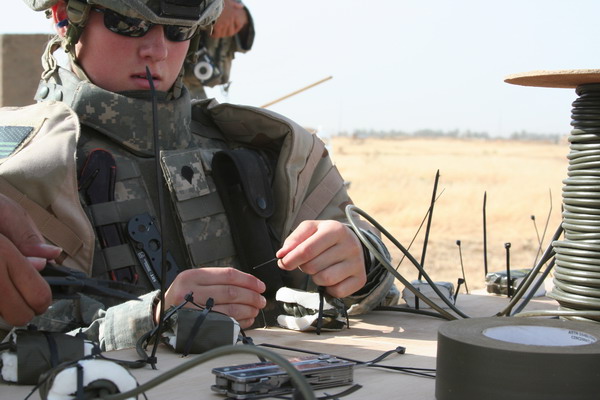
The finished product, proudly on display and ready to be placed.
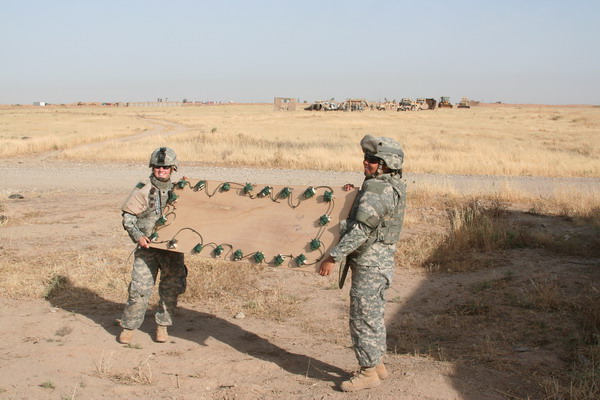
Here it is in place and the fuse being lit.
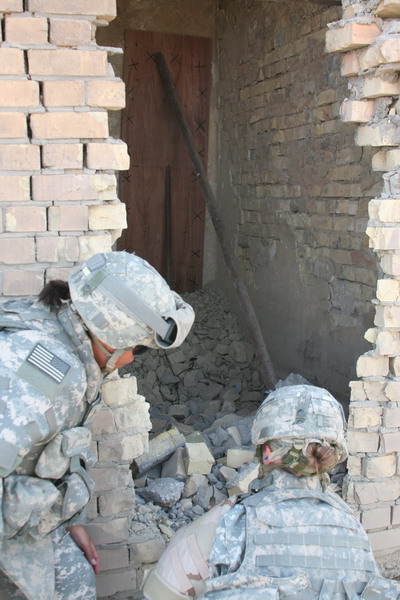
Boom.
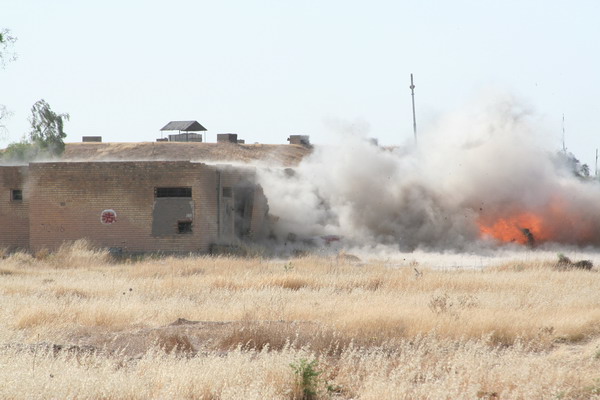
The base videographer, Roidan, was on site to document the event as well.
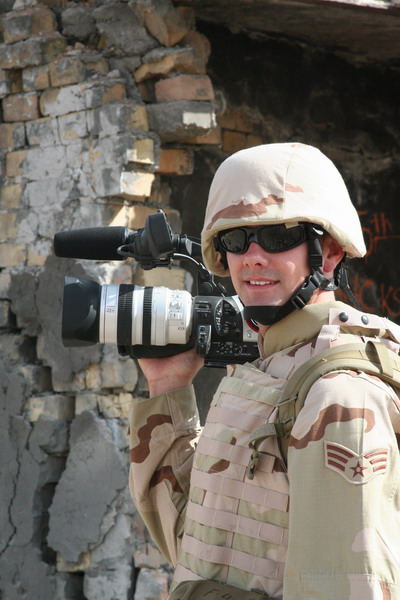
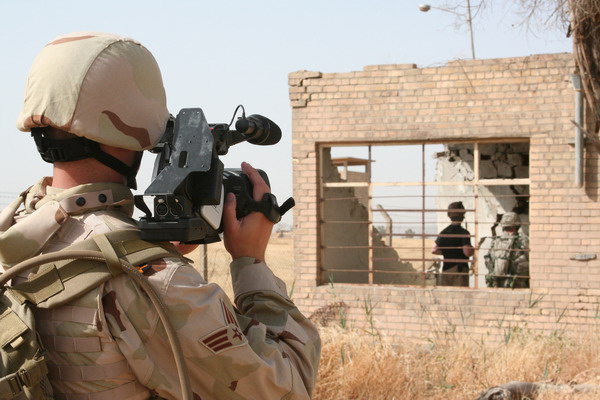
This is an interview with the Engineer Company First Sergeant, who was the main force in setting up this operation.
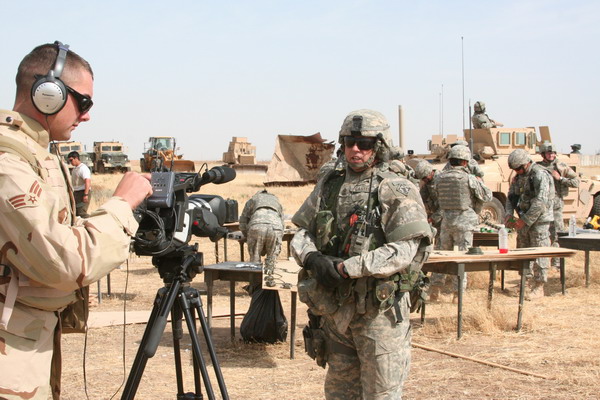
Since it took a while to inspect the damage of each blast and place the next one, the soldiers took refuge from the heat in their vehicles.
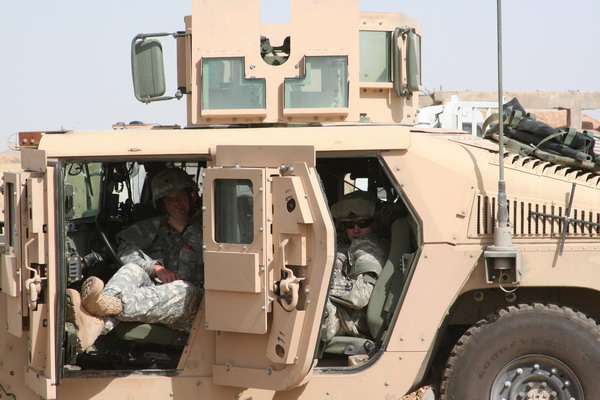
Lighting the fuse … Ready.
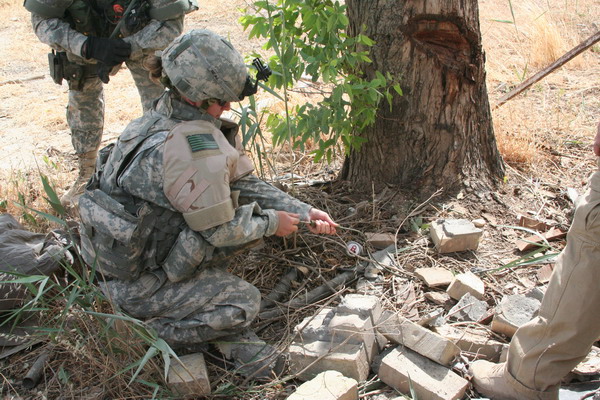
Set…
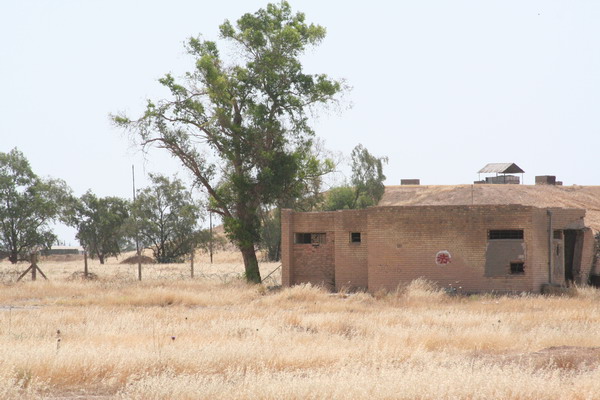
Boom.
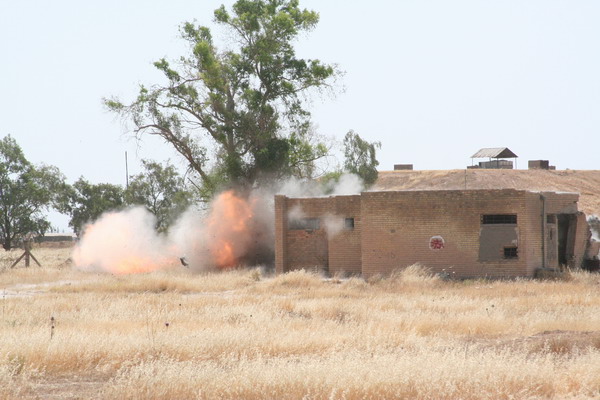
Here I am standing on the partly destroyed building.
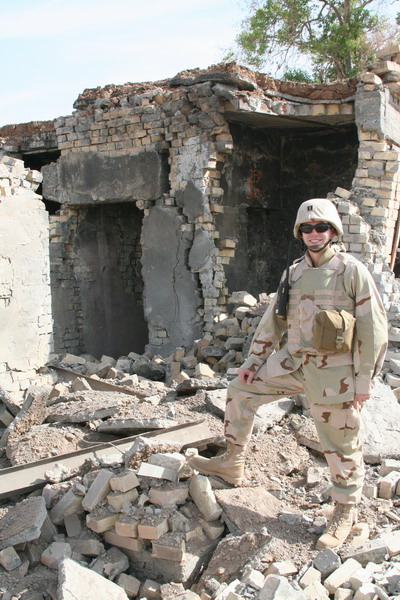
Setting another charge.
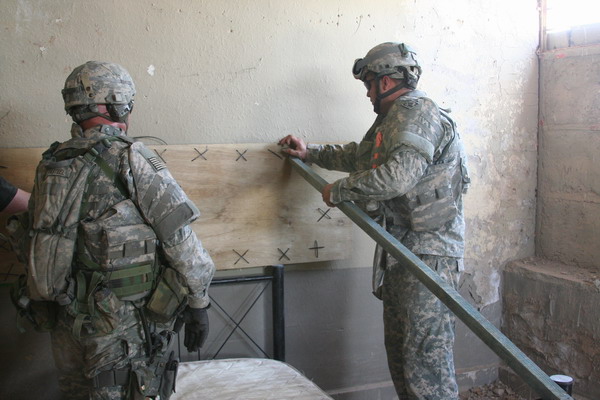
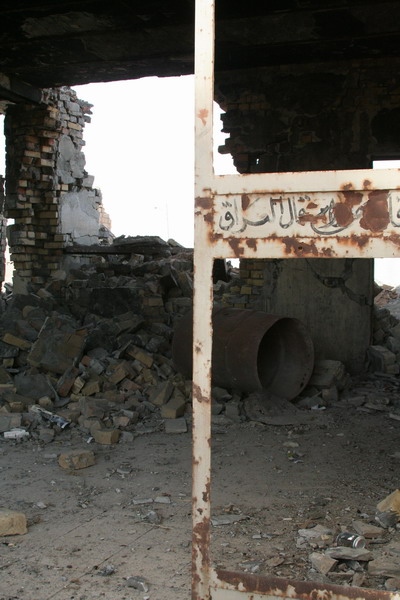
Ready to blow again.
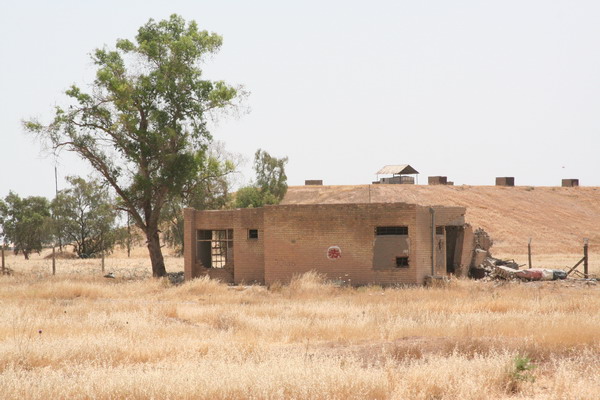
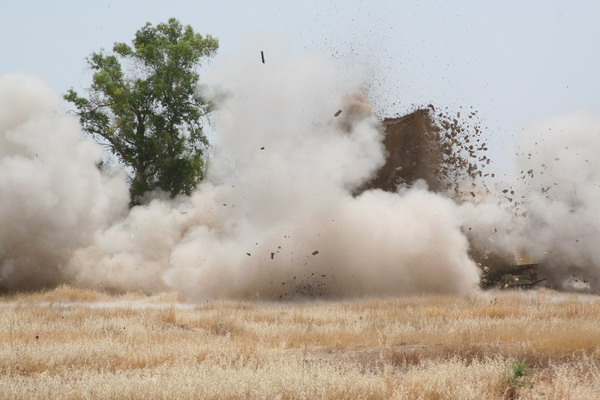
It’s starting to look more like a pile of rubble than a building. A few more blows and there will be nothing left.
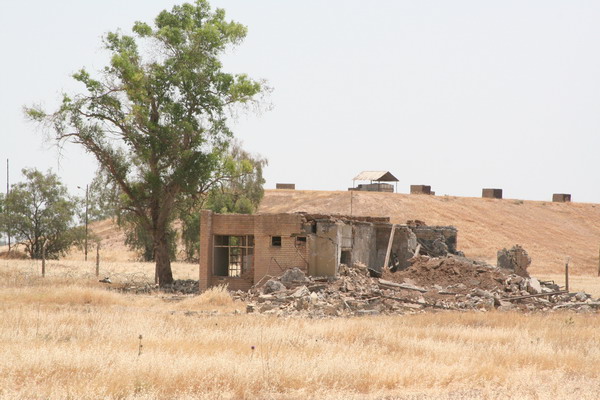
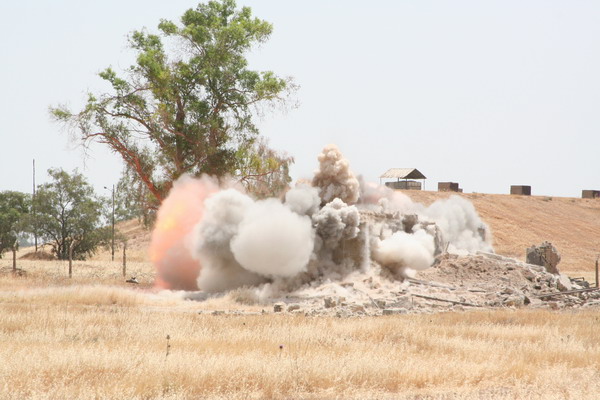
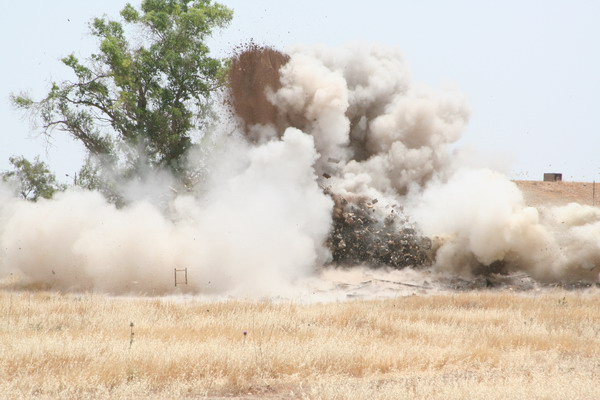
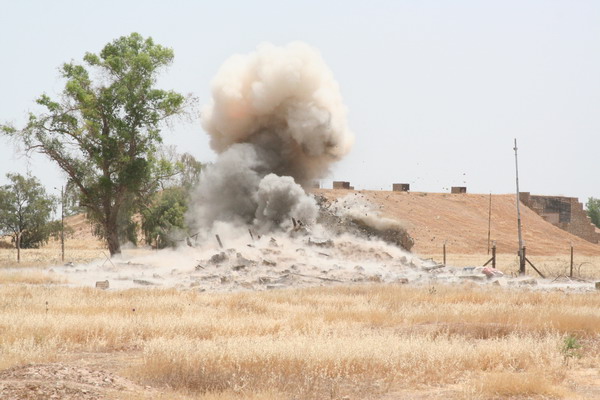
After the day’s explosions. This is all that was left.
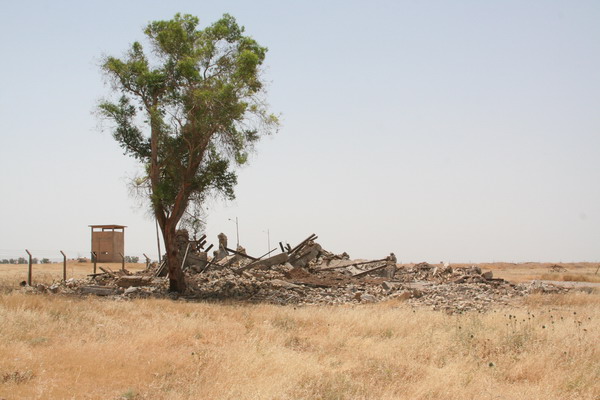
It was a success for everyone involved.
–Jim
Deployment begins…
This begins by deployment to Iraq. I have decided to continue updating the website as more of a traditional blog, instead of a travelogue.
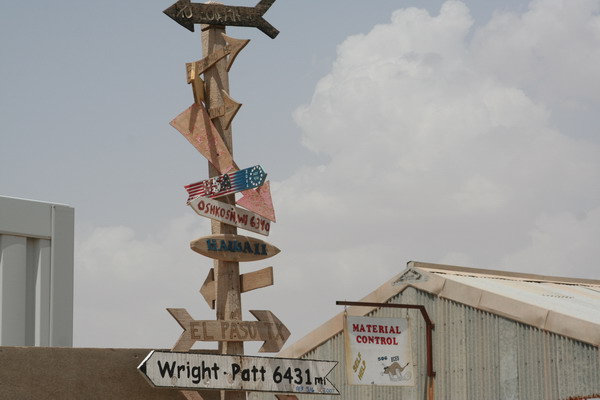
Hello again everyone. Well, I have arrived at my new home for the summer/fall. Even though I have deployed before, it’s certainly a bit of an adjustment to re-acclimate to the deployed environment.
Now, let me fill you in on some of the details that have taken me from Germany to Iraq.
The US military is second to none in its ability to transport personnel and equipment from one place to another. However, it was still a very long process to gather all the requisite gear, process the right documents, attend briefings to make sure Anna and I had all the information we needed, and finally to assemble that gear and start the journey to our final destination. All told the transportation alone took three and a half days, and Germany is only two time zones away. I point this out to imagine how far we, as a military, have come. A comparable trip only a half century ago would have taken much longer.
Let me explain some of the logistics involved. We were transported by bus to an air terminal. We waited there for about 8 hours, before going back home for the night (the plane had been delayed). It was nice to be able to go home again and spend another night with Anna. It actually made leaving a little more palatable for both of us. The next day, we repeated the process, except this time, the plane actually arrived. However there was more maintenance problems, so we were delayed again, but eventually left.
One of the little know facts about US Air Force transports is that we utilize something called the Civil Reserve Air Fleet. That is made up of civilian passenger and cargo aircraft to supplement military transports when the demand exceeds the military’s intrinsic capability. As of the end of last year, there were 39 carriers and 1,379 aircraft enrolled as part of the Civil Reserve Air Fleet. That translates to over $2.5 billion in contracts to civilian aviation. For example, the plane I flew over on was an ATA jet, filled with Airmen in their desert camouflage uniforms. Quite a site to see.
Anyway, after about a 4 hour flight, we arrived in Qatar (where I spent a significant amount of time on my last deployment). There, we found out our follow on flight to Iraq was a day later, so we got to enjoy the transient lodging accommodations. We (the five guys going with me) were in a large tent filled with about 50 bunk beds. Fortunately, we were the only ones there. Since we got in at about 3 o’clock in the morning, I decided to enjoy sleeping in a little bit. After wandering around during the day (and saying hi to a couple friends deployed there … hi, Brian and Katie) we gathered all our gear up and went back into the passenger terminal to wait. I think we ended up waiting for about 7 hours (more plane troubles), but eventually loaded up into a C-130. For those who have never had the pleasure of traveling by C-130, the mighty and venerable Hercules, I will explain a little of what it’s like: imagine cramming in to sit on cargo netting. Your neighbor on either side sitting so close that your shoulders are touching. To top it off, the people sitting across from you, are so near that you have to overlap your knees. So, there we sat with all of our gear on (Kevlar helmets and ballistic body armor) for our 4 hour flight. Unfortunately it seemed to be a trend, and we had to make an unplanned stop in Kuwait. Not to worry though, it was minor and we were back in the air in no time (well, actually, it was about 2 hours). Eventually, we arrived in Kirkuk, our final destination the next morning. The Airmen we were replacing met us at the airport and looked VERY happy to see us.
I spent the next several days learning as much as I could. Soon though, the Airmen we replaced headed out the door to return home. They had spent four months here and were ready to go. That brings up another interesting point. At this base, we have many joint operations with the Army and Iraqi Air Force (along with their American transitional team). So, it’s interesting to notice that the Air Force deploys its Airmen for somewhere bewteen 4 and 6 months. While the Army keeps their soldiers here for a year, but the ones here right now just found out they have been extended to 15 months. Even so, the morale of the base is remarkably high.
What do I do here? Well, without getting into too many specifics, I help manage the base’s infrastructure with maintenance, repair and minor construction. However, it’s the team of guys here with cross functional expertise to make that a reality. We in the Air Force, with the exception of our explosive ordinance disposal teams, stay exclusively on base to manage the base and our Air Force mission. It’s the Army soldiers who go out to patrol / protect the city of Kirkuk.
Kirkuk is a fascinating history and although I can only see it over the wall or through a fence, let me share a few of its highlights.
Kirkuk is in the Northern section of Iraq (about 240 kilometers north of Baghdad).
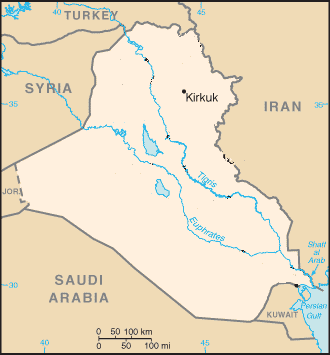
The approximately 750,000 residents of Kirkuk are very ethnically mixed among Kurds, Arabs, Assyrians, Turkmen and Armenians (plus both Shi’ite and Sunni Muslims live here). The big debate is the upcoming referendum in November or December 2007. It proposed, under the new Iraqi constitution, to have Kirkuk decide if it wants to join the Kurdistan Regional Government. That means that the 120,000 people forced out by Saddam after the 1991 Gulf War, who were replaced by tens of thousands of Arabs in an attempt to “Arabize” the city/region, could return home. That will effectively swing the balance of power toward the Kurdish ethnicity.
Another interesting, non-political fact about Kirkuk is that it is believed to hold the Tomb of David, a biblical prophet. But, there are at least two other sites that also claim to hold the tomb of Daniel. Probably the most famous story of Daniel is when he was cast into the lion’s den, but walked out, untouched.
So, hopefully, that gives you a little flavor of the area I am staying in and doing my part to help stabilize.
So, until the next post.
–Jim
The Black Forest
As the final leg of our adventure, we decided that a little relaxation was in order.
So, we drove north, through the fairy tale land of Germany’s Black Forest. This forest is known for Cuckoo clocks, ham, grandfather clocks and is the setting for many of the Brothers Grimm fairy tales.
As we drove (and got out to hike around a couple times), we thought for sure we would see Hansel and Gretel crossing the road. Perhaps Rumpelstiltskin would be sitting next to the large tree, just over there… but alas, it was not to be. We didn’t meet any of those characters, merely an enchanted forest.
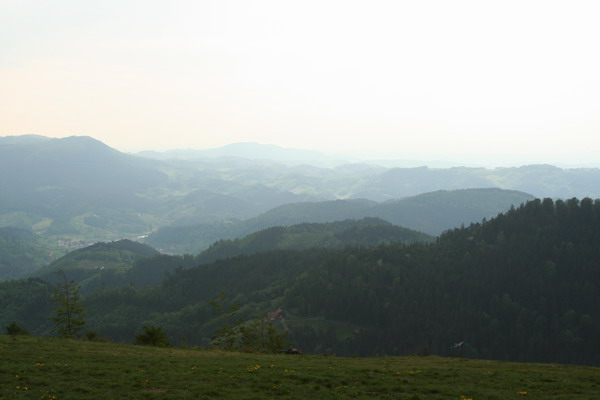
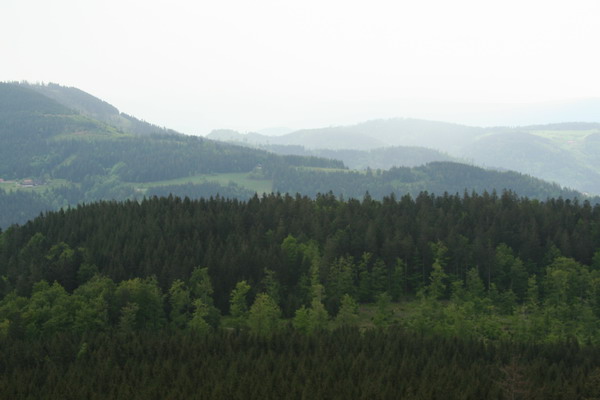
We also stopped by this small lake called Mummelsee. Legend has it that there is an evil sea king who lives in this deep lake. However, it’s only 17 meters (55 feet) deep and we didn’t see anything remotely evil, except perhaps the large parking lot that holds buses containing streams of tourists during the high season.
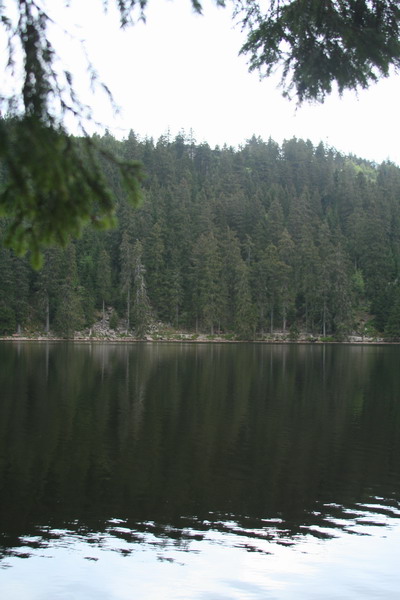
Although Mürren was very low-key, there are few places to relax better than a stay in the German city of Baden-Baden. As I type this, I am in a large square, using ubiquitous wi-fi to access the site. There are people all over, cafes serving coffee and food and a fountain of mineral water bubbling over rocks. It’s that mineral water that we came to enjoy. This city has been known as a bath town since Roman times. There are naturally heated springs flowing underground and two large spas have tapped into them.
Purportedly, former President Clinton said “Baden-Baden is so nice,
that you have to name it twice” after he and Hillary visited. And, while we wouldn’t rely on water to cure any ailments, Mark Twain was so enamored after his time here, he said, “I firmly believe I left my rheumatism in Baden Baden. The town is welcome to it. I would have preferred to leave something catching, but it was not in my power.”
We began our visit here with a stroll along the Lichtentaler Allee and popped into this rose garden. While it’s a little early still for the roses, it’s still pretty.
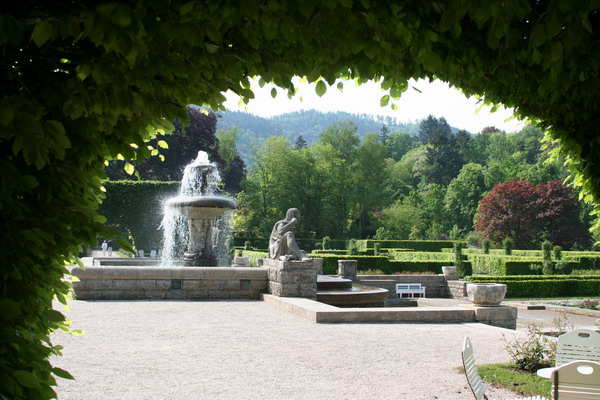
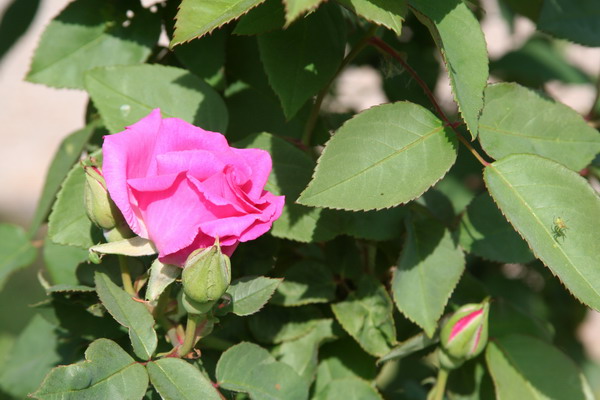
Farther down the Lichtentaler Allee, we found more flowers…
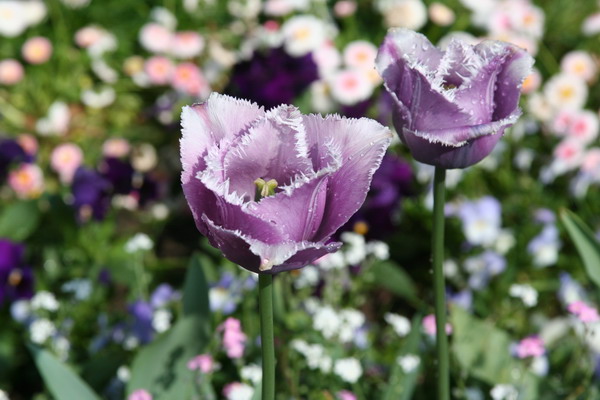
And some aquatic friends.
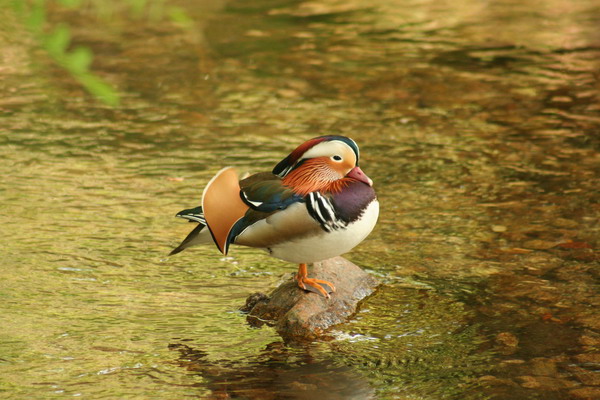
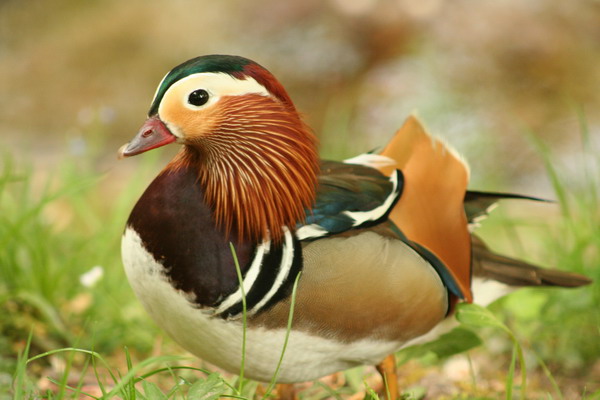

Now, back to the baths. Although I don’t have any images to share with you all, we did go to both of the major baths, the Friedrichsbad Roman-Irish Bath and the Caracalla Therme Baths. Both are supplied by naturally heated underground mineral water. They were very different, but both were relaxing. Our favorite was the Friedrichsbad Roman bath, which takes bathers on a sixteen stage journey of cleanliness and relaxation in an elegantly decorated building:
1. warm water shower
2. warm air bath 54 C (129 F) (also known as a sauna)
3. hot air bath 68 C (154 F)
4. shower again
5. soap and brush massage (if you pay the extra charge, which we did)
6. shower … again
7. thermal steam bath 45C (113 F)
8. thermal steam bath 48C (118 F)
9. thermal full bath 36C (97 F)
10. thermal whirl pool bath
11. thermal kino-therapeutic bath (read: lots o’ bubbles)
12. shower one last time
13. cold water immersion bath 18 C (64 F) and let me tell you, this one was cold, but surprisingly very refreshing!
14 dry off with a warm towel, which feels divine after the cold water
15 application of moisturizing cream (to reverse the raisin process)
16. rest area, where for 30 minutes you are bundled up cocoon-like in blankets (and most people doze off for a while).
After that experience, we wandered the town center on a cloud. It was a great bathing experience. This morning, we also sampled the mineral waters in Caracalla. It was more of a recreational facility with a number of baths. However, there was no focus on the relaxation. The best part for us was the variety of indoor and outdoor pools. It even had a high speed lazy river, that was like floating on a giant bottle of mineral water.
So, after our relaxing stay in the Black Forest, we returned home. Unfortunately, this will have to be our last trip together for a while. I am headed out to Iraq next week for about 6 months. I don’t know if I will continue to post, but either Anna will post her continued travels, or if nothing else, this winter, we will have more joint trips to share with you all.
So, until then…
–Jim
Switzerland Part 2 — Mürren
After our adventures in the Interlaken Valley, we moved our base camp further up the mountain to the village of Mürren.
This magnificent little village is only accessible by hiking trail and train. Since we had a bit of luggage (including the computer I’m typing on), we opted for the easier, but still picturesque train.
The period after Easter until mid-May is in between the winter and summer seasons. So, most shops (and people) are closed/gone on holiday. Fortunately, in early May, some places are opened back up. Such was the case for the B&B where we stayed. The owner of this lovely place, Denise, opened a day early. It was the perfect location and if you decide to trek to Mürren, we highly recommend the Chalet Fontana.
Since there are no cars in the town (except a couple work trucks that seemed to be everywhere at once!), hiking was the plan for our time there.
Mürren is on the east side of the Lauterbrunnen Valley and offers a great view of the Eiger, Mönch and Jungfrau mountains on the other side of the valley. Although this is a resort town, we virtually had the place to ourselves. The hiking trails were very easy to navigate and gave views that are second to none. As you can see here, at 1,650 meters (or 5,400 feet), it is often already above the clouds.
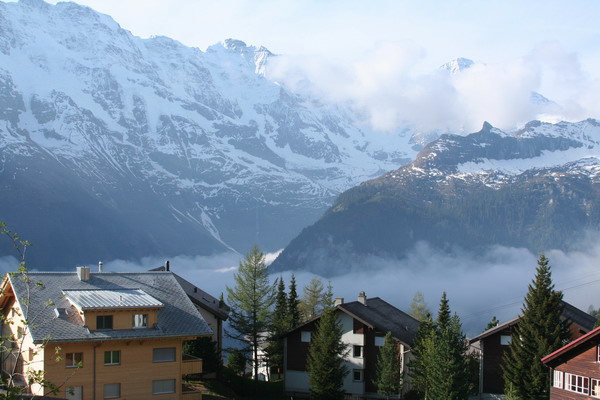
Here’s a perspective of Mürren as we emerged from the trees.
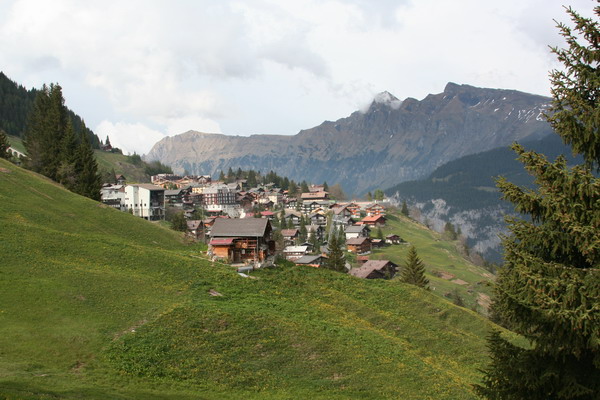
Unfortunately, there wasn’t an abundance of wild fauna, but there were quite a few domestic and relatively tame ones for our viewing pleasure.
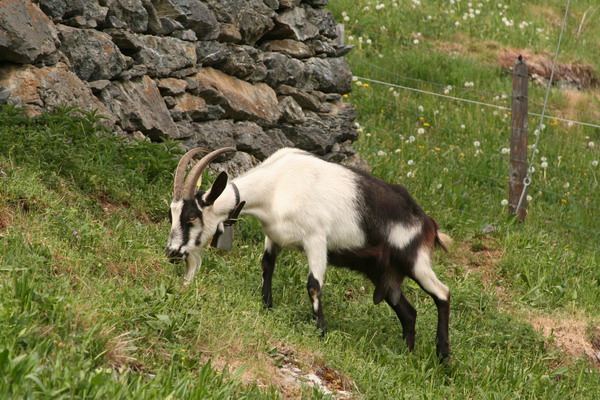
Here we are on another hike. This is one of those times I wished I brought a tri-pod with (or that there were other people on the trail). So, I used a small pile of rocks instead. Anna makes a nice blond pine tree, don’t you think?
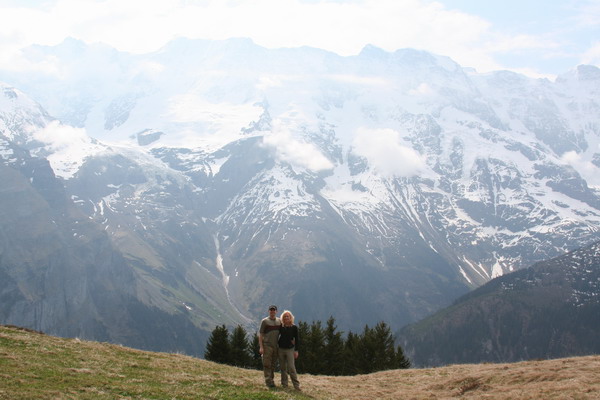
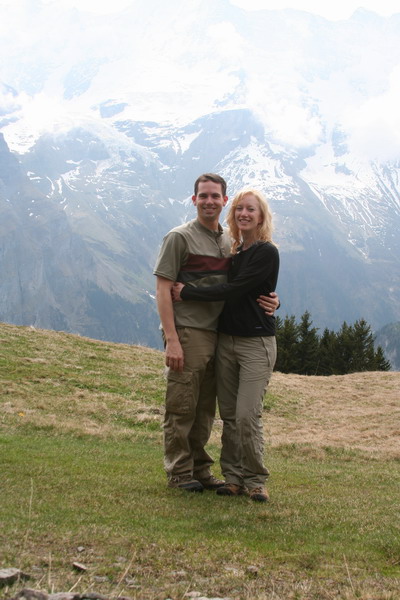
Here’s the view back down to Mürren.
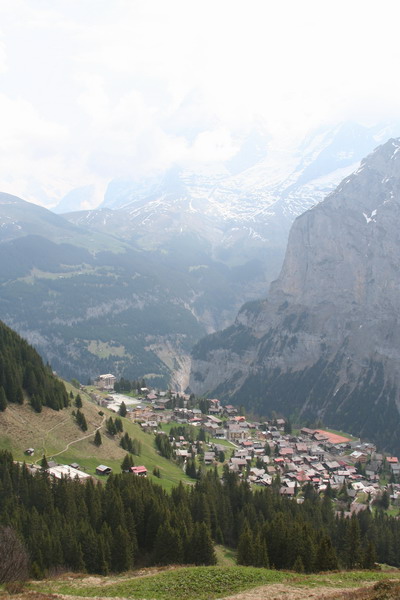
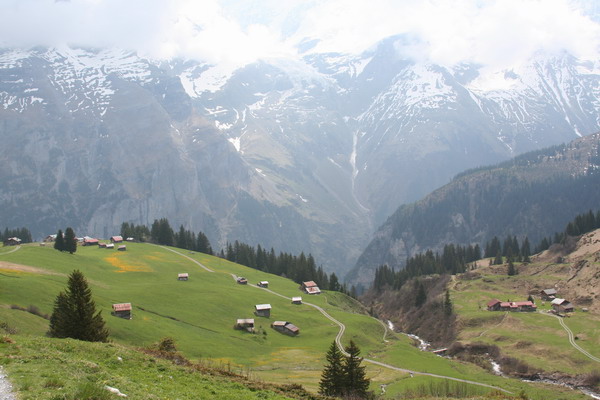
The mountain wild flowers were very pretty too.
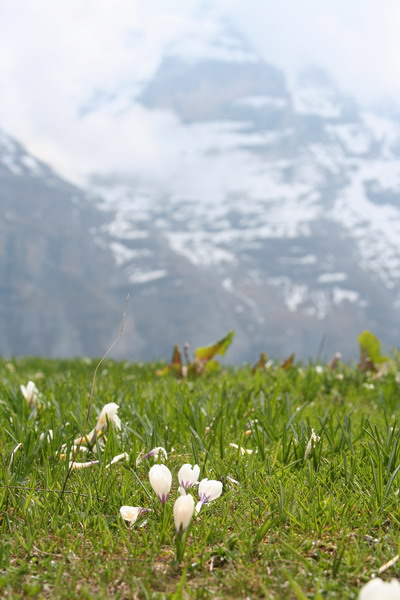
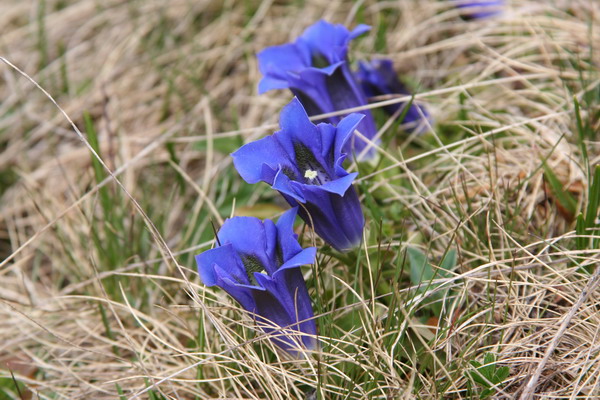
The plan for this hike was to go all the way up to the gondola station, Birg (2,677 meters or 8,800 feet), then ride that up to the peak of the Schilthorn (2,970 meters or 9,750 feet).
However, for those who have accompanied us on hikes in other locations you know that I can be a little zealous in my hiking goals… This time though, Anna talked some sense into me. The clouds covered Birg and she said she saw lightning. While I didn’t see the lightning myself, I trusted her judgment and reluctantly acquiesced, so we headed back down the mountain.
Anna wanted this picture as proof that it was indeed bad weather…
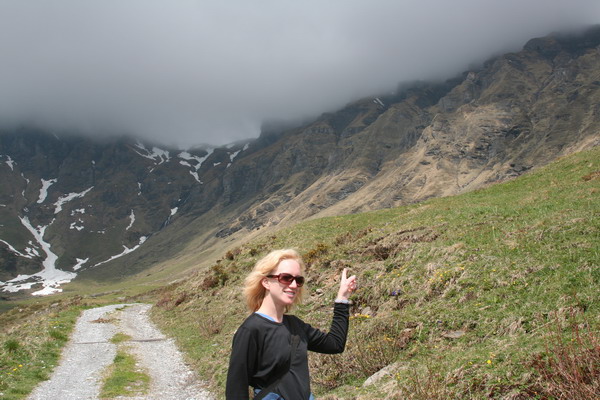
The next day, it had cleared up sufficiently to actually see Birg and the Schilthorn Peak. Instead of retracing our hike to re-attempt the peak, we opted for the easier gondola. Again, since it was early season, the ticket prices were reduced (although still expensive).
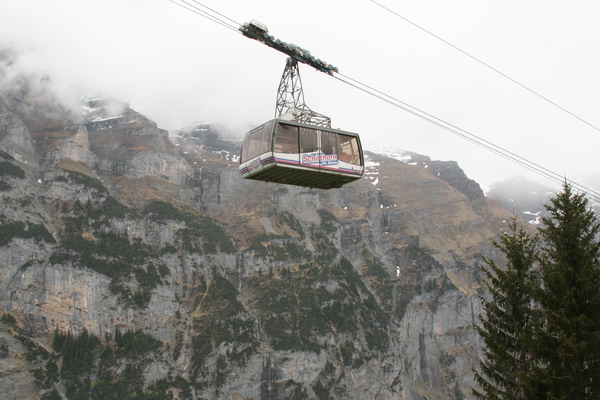
On the peak there is a revolving restaurant called the Piz Gloria. It was completed in 1968 and it’s claim to fame is that before it opened to the public, it was used in the James Bond film, “On Her Majesty’s Secret Service” in 1969. For those who have actually seen the film (neither Anna nor I have), it was the one where George Lazenby played 007 (after Sean Connery and before Roger Moore). The view, although partly obscured by the haze and clouds was still beautiful.
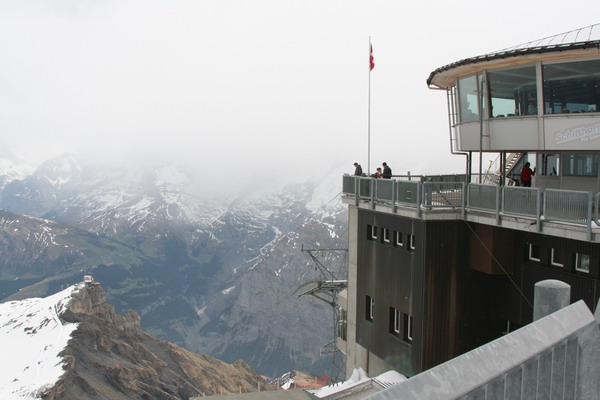
Here is the view looking back down at Birg. You can see there was a bit of snow on the trail. As it has been in Germany, this spring has been exceptionally warm. Denise told us she skied down from here just two weeks before. Now, there’s hardly any snow left. Perhaps next time we come back, we’ll come to ski (and hike).
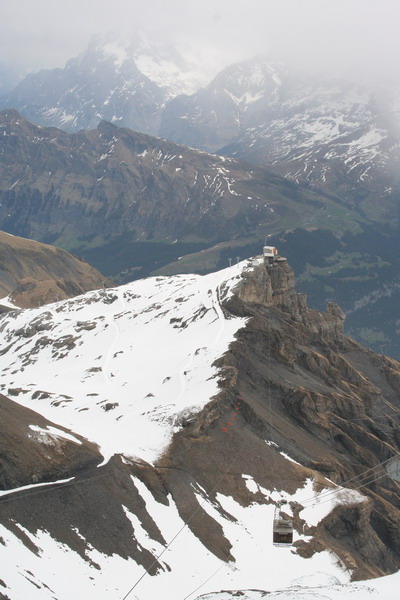
Yet another view of Mürren. I couldn’t help myself, it was just too cute.
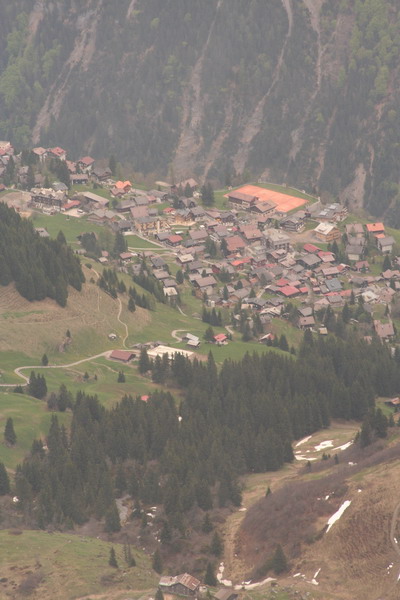
Here are a few images from yet another hike. This time down past the smaller (even more remote) village of Gimmelwald. It has been saved from further development by its designation as inside an avalanche zone.
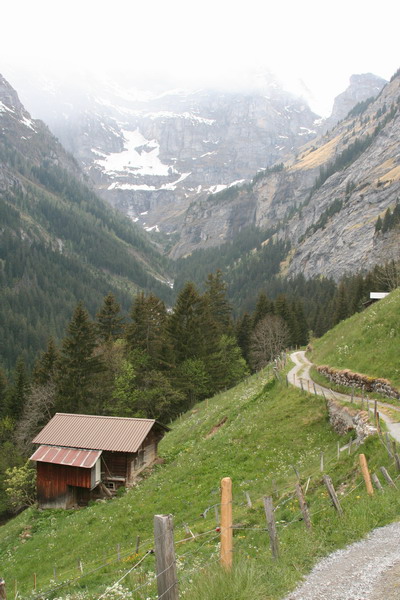
There were pretty wild flowers here too.
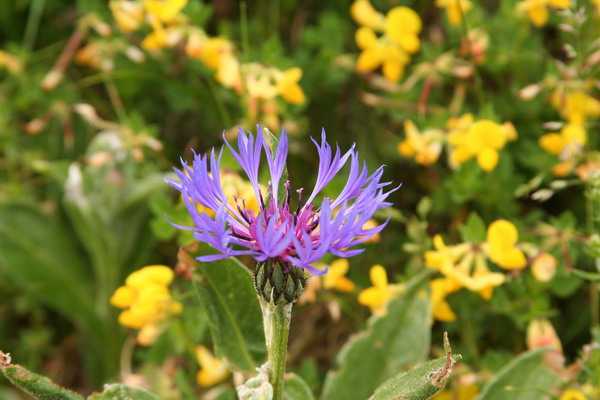
This waterfall was Anna’s favorite.
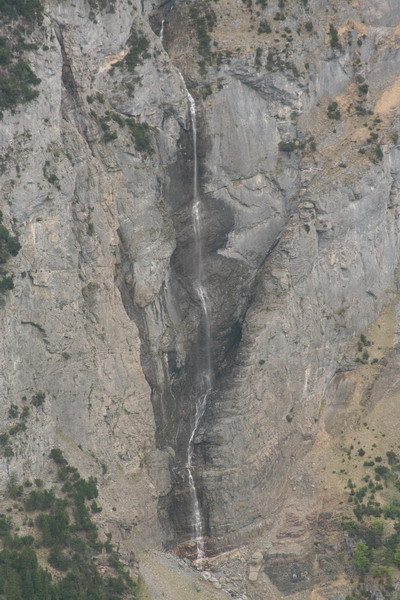
Trümmelbach Falls was my favorite, but this one was my second favorite.
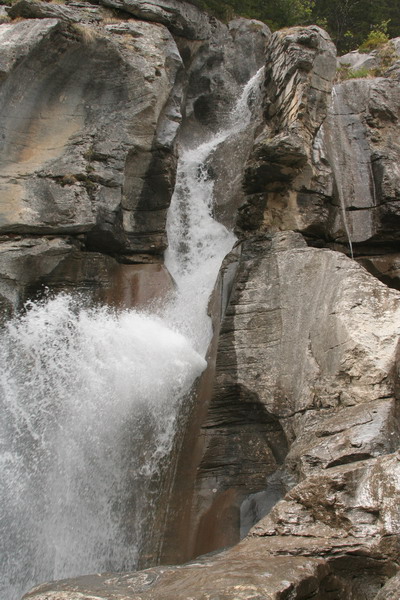
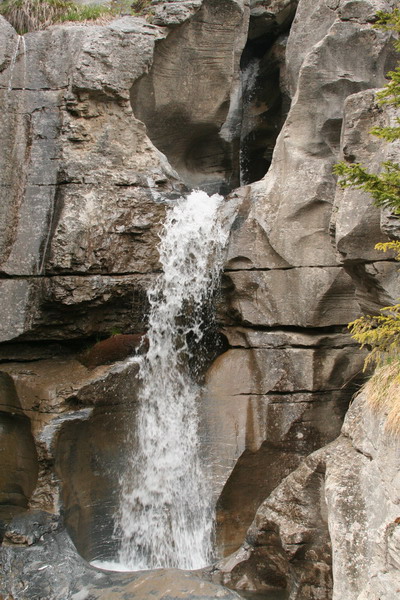
Swiss architecture all over the country was beautiful, but in the mountains, the combination of synthetic and natural was amazing.
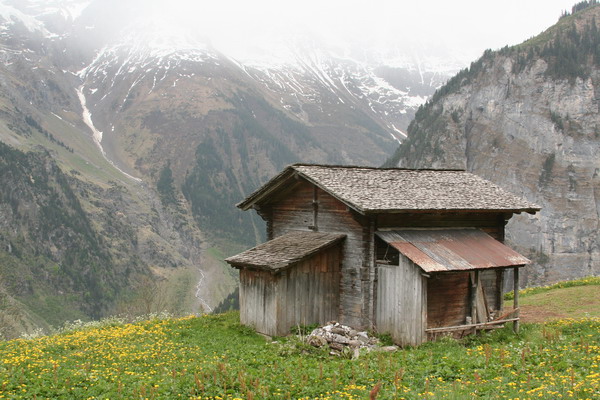
The next morning, we packed up our bags and headed back down on the train. We really enjoyed our time back in the mountains. It was hard to leave, but we are excited that the Alps are only a (relatively) short car-ride away.
Up next is a bit of relaxation in the bath town of Baden-Baden on the edge of the German Black Forest.
–Jim
Switzerland — Interlaken adventures
The past few days, Anna and I have enjoyed an adventurous trip to Switzerland. We picked the city of Interlaken for the magnificent landscape and the variety of adventure sports it offered. The first day, we got acquainted with the city.
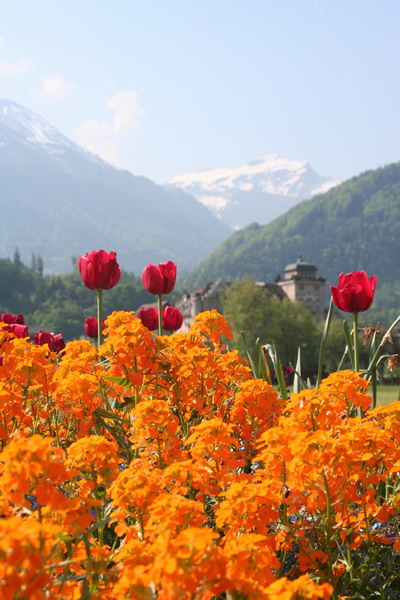
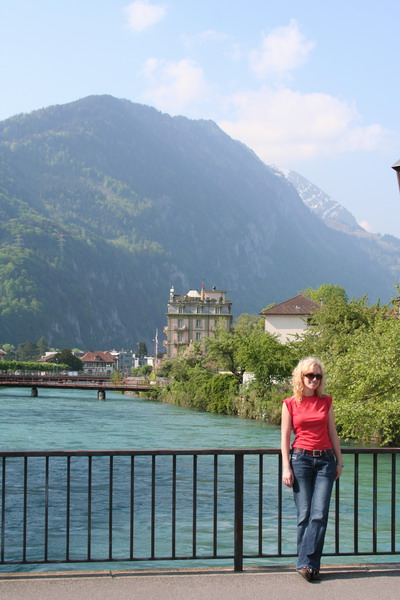
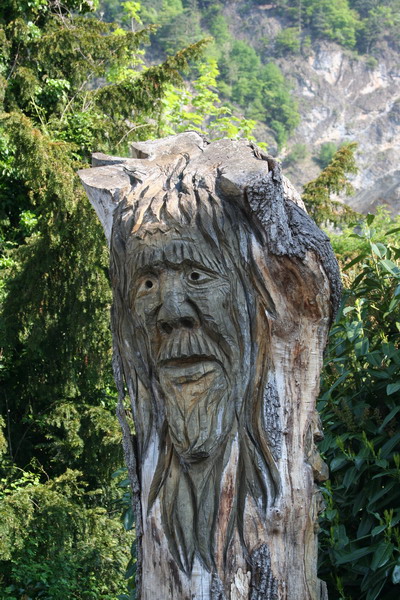
Next, we decided to see what type of adventure we could find. We heard that the paragliding was especially nice.
This is our group. To paraglide with tourists, you have to have a commercial rating (much like an airline pilot, but with less flight time required). So, when we got to the top of the mountain, we had the privilege of choosing our pilot. When was the last time you got to have a lineup of pilots and you choose the one who seems the most qualified?? 🙂 Fortunately, Anna and I chose wisely and we had very knowledgeable and skilled pilots to accompany us on the journey down to the valley floor.
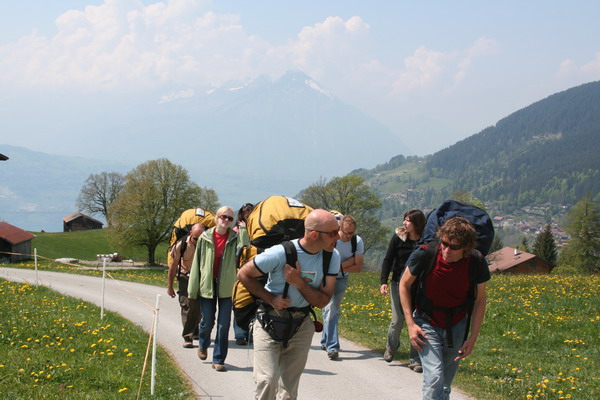
One of the reasons paragliding is safer than sky diving is that you can inspect the chute and lay it out in the right position before you
leave the ground. When you are free falling at 120 MPH, you don’t have the same luxury. Plus, the risers can become entangled and not let the chute fully inflate. With this, all of that is avoided by a simple pre-flight inspection.
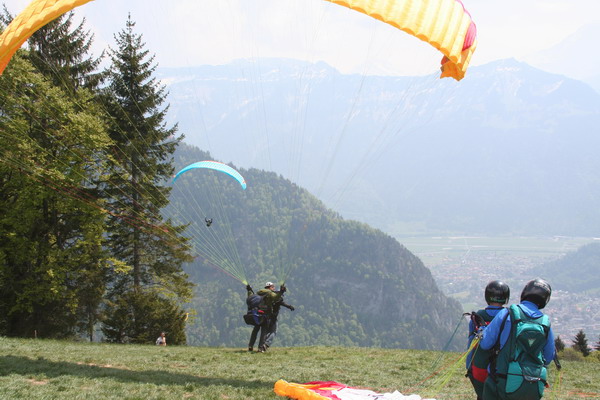
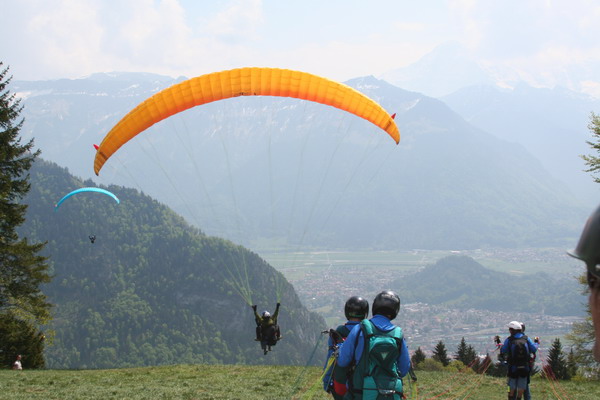
There were plenty of hang gliders launching from the same point.
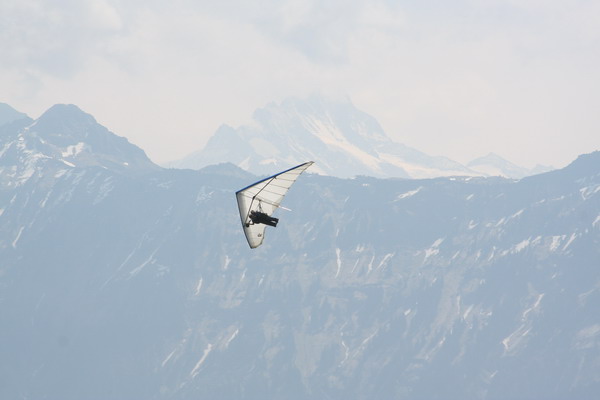
This is an aerial vantage point of the launch point.
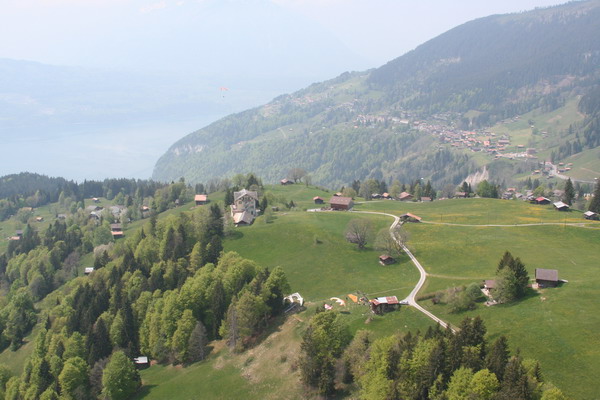
Here is Anna and her pilot flying over Lake Thun (one of the two lakes that surround Interlaken, or “between lakes”).
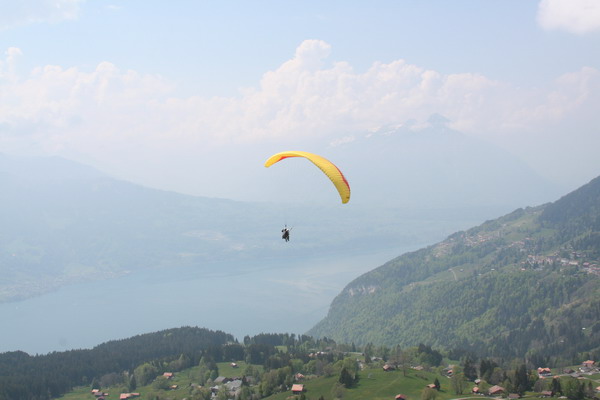
Here’s a solo flier that gives a better perspective of what it’s like.
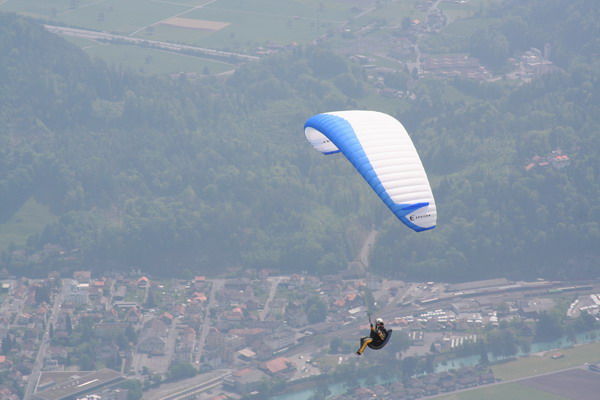
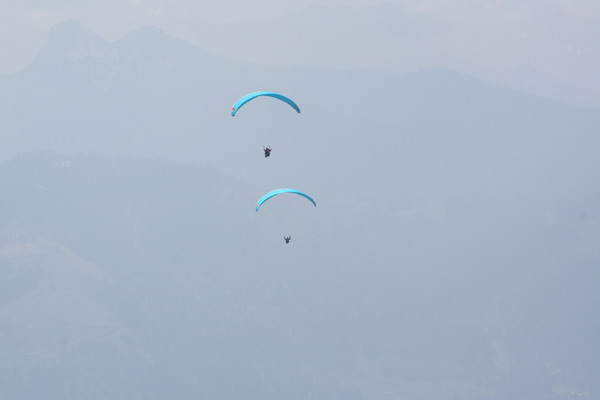
This is Interlaken with Lake Brienz in the background.
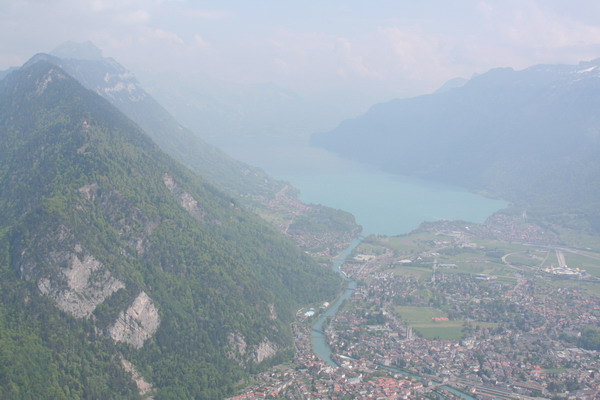
Anna flying high…
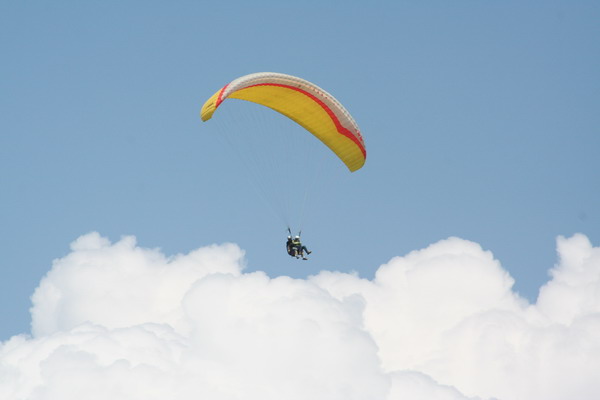
Landing is always the trickiest part, especially when both people are so close together.
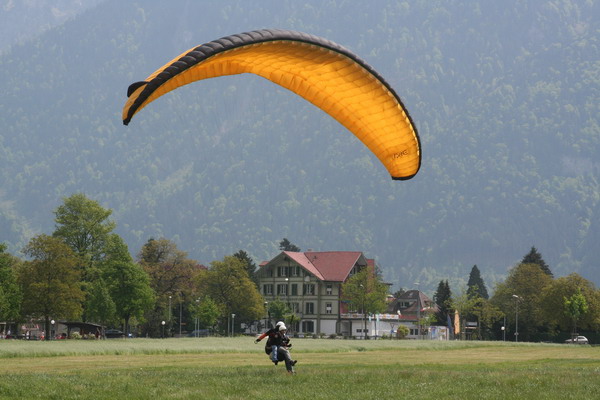
Here’s Anna on short final.
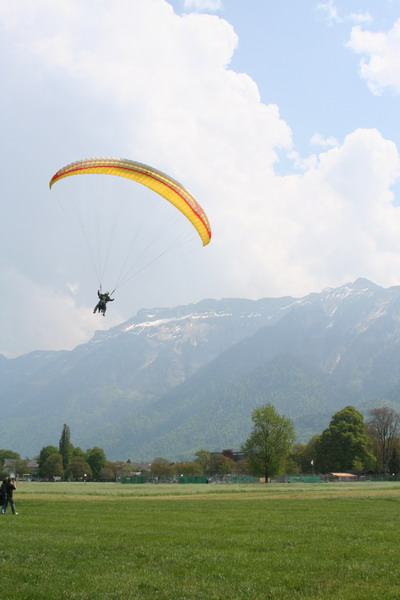
Touchdown.
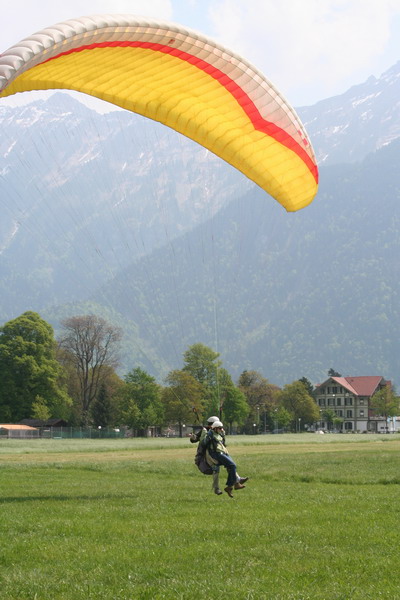
Once back on the ground, she walked away with a little swagger in her step. 🙂
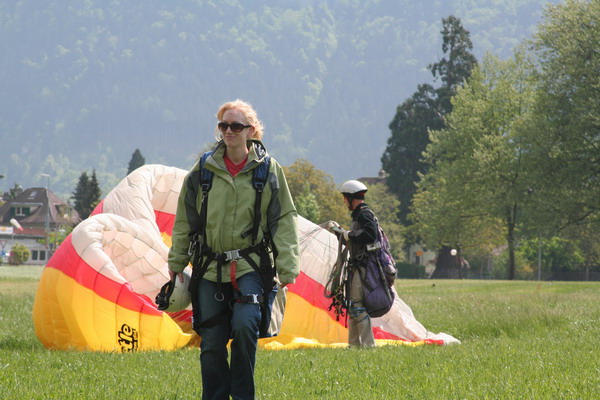
Later, we decided to take a short drive up to the Jungfrau Valley, past the little village of Lauterbrunnen.
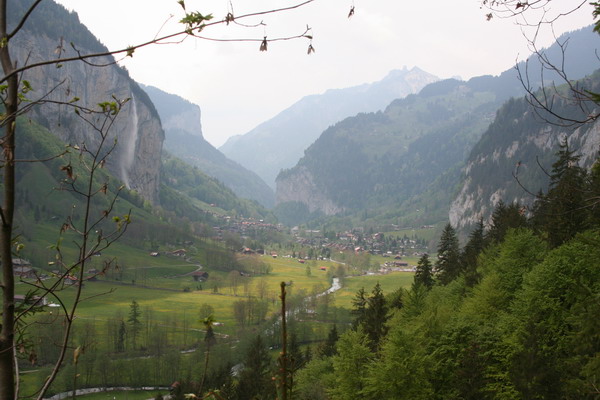
Inside the side of the mountain, erosion from glacial runoff has created a spectacular series of waterfalls. Most are inside the mountain and small tunnels have been cut out of the rock so you can go inside and have a closer look at 10 of these beautiful waterfalls. This is just down stream from the first falls. The water still retains that blue hue of ancient glacial ice.
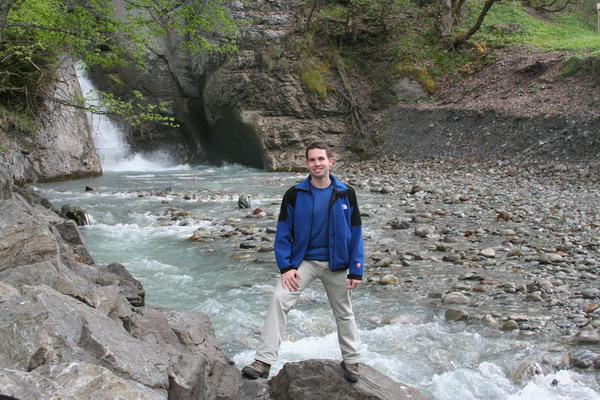
These images are from inside the mountain.
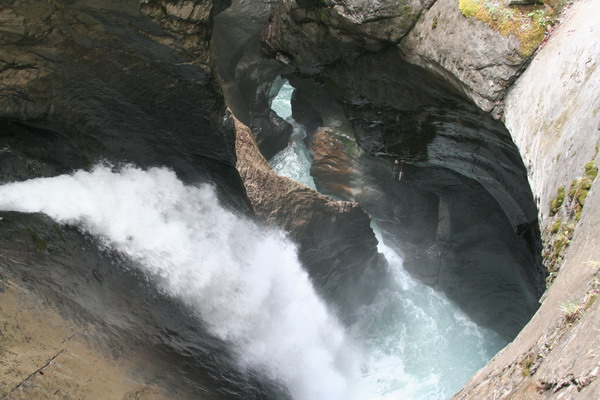
The water courses through the mountain at an average of 100 cubic feet per second (or about 3 cubic meters per second).
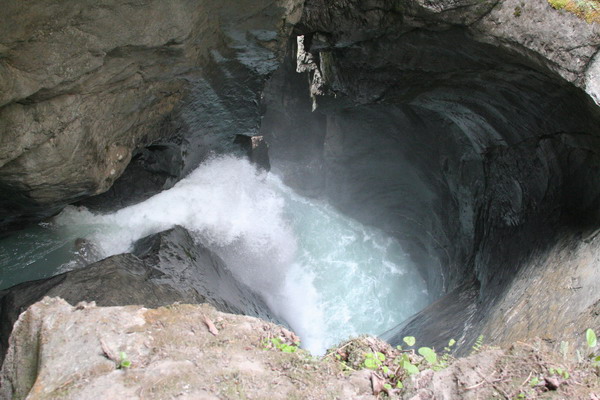
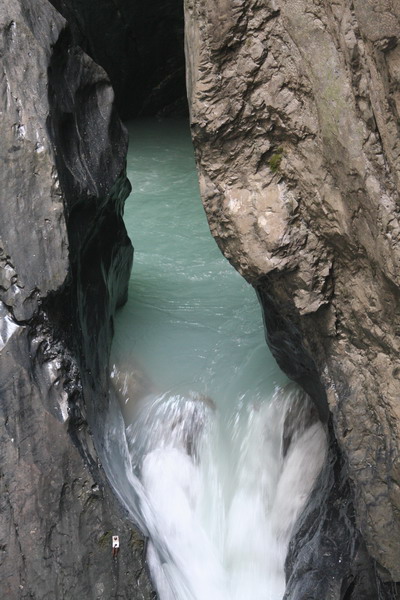
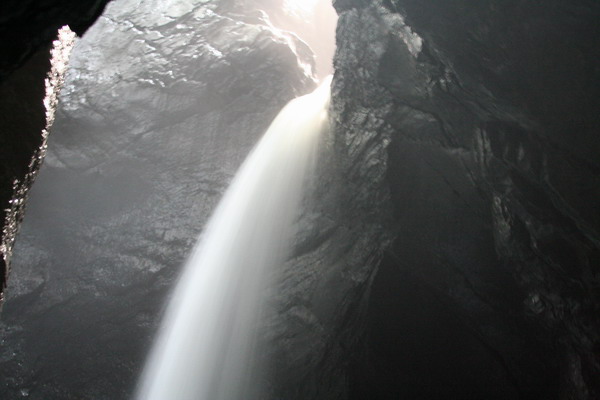
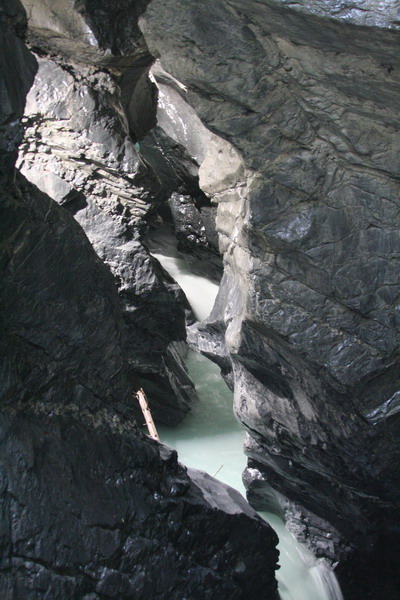
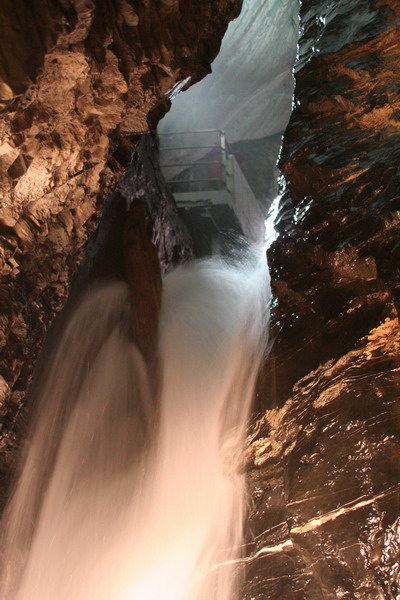
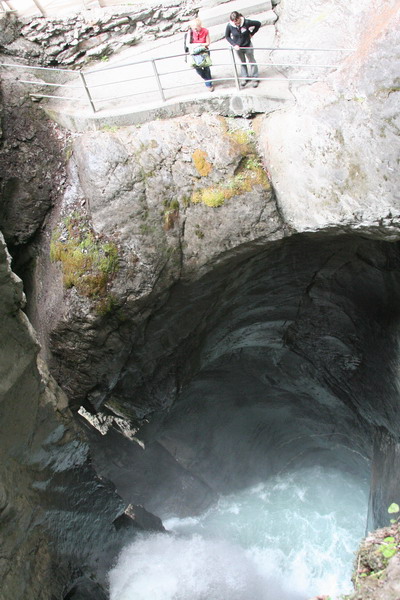

Our next adventure is a fairly new and popular European sport: Canyoning. Since it hasn’t really caught on in other parts of the world yet, let me explain what it involves. Basically you take a group of people (often the younger, “I feel like I am indestructible” types), add a couple of guides, put everyone in thick wetsuits (to ward off the bone numbing cold that comes from glacier fed streams) with life jackets, helmets and finish with a harness, then head to the nearest canyon (with a river or stream in it of course). Next comes the easy part: go from point A to point B in the canyon. Of course getting there is where the fun is. For our canyoning adventure, we hiked across stones, through the water (floating and swimming), jumped off several cliffs (not to worry though, nothing was over 30 feet), slid over natural waterslides into deep pools and rappelled off a cliff in a manner that was more like a zip line than an actual rappel.
As you can imagine, that environment is not conducive to taking pictures. So, all I have is this image from the point where we finished and had lunch.
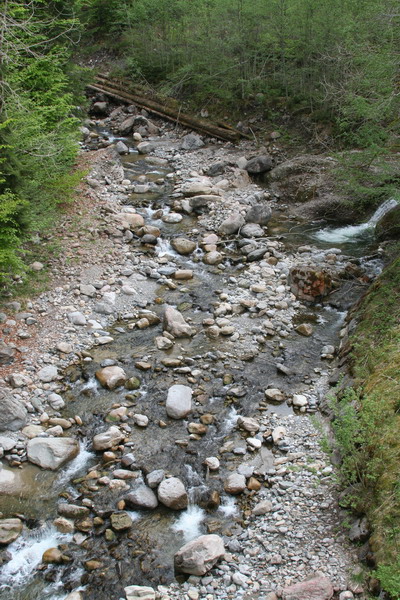
The next stop on our itinerary (and where I am writing this from) is a little town in the Lauterbrunnen Valley called Mürren.
The next post will cover our adventures (hiking), here in this charming Swiss village where cars are not allowed.
So, until then…
–Jim
Rome — part 2
OK, this entry will take you through ancient Roma.
Perhaps the most well know monument is the Flavian Amphitheater, but because of the mammoth 100′ tall statue of Nero that used to adorn the entrance. However, today it’s simply known as the Colosseum.
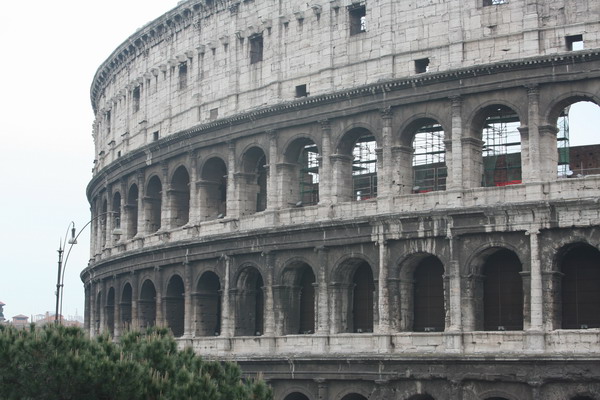
Here you can see a re-creation where the floor of the of the Colosseum was. This perspective allows you to see the inner workings below. Gladiators, or animals could be moved around under and raised up to the surface. Can you imagine seeing African animals like lions, elephants or rhinos for the first time ever as they were used in gladiatorial contests?
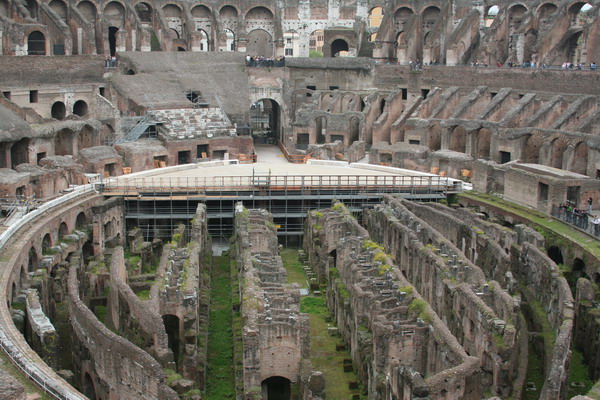
It was in use for nearly 500 years (after it was completed in 80 AD by the emperor Titus). It could hold 80,000 people. The form of the Colosseum is nearly identical to that of our modern arenas.
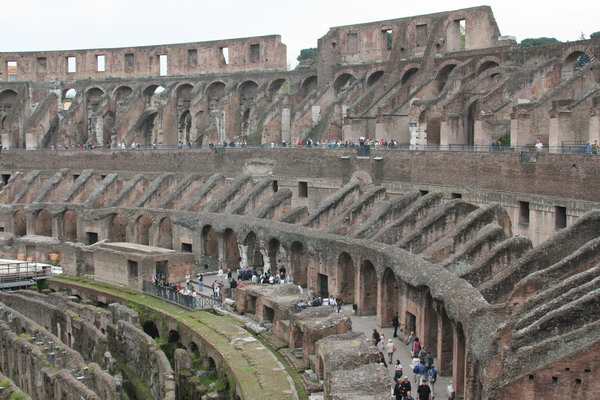
Unfortunately, earthquakes destroyed much of the south side in the mid 14th century.
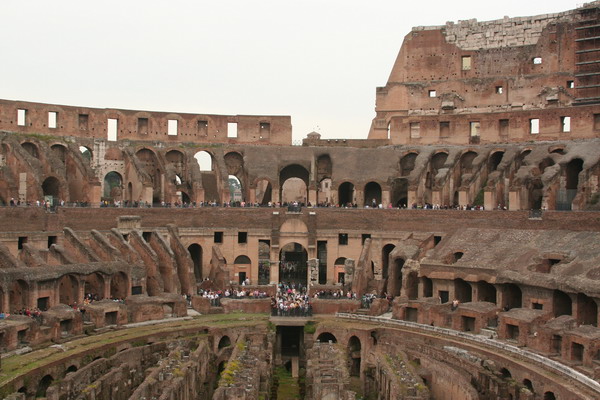
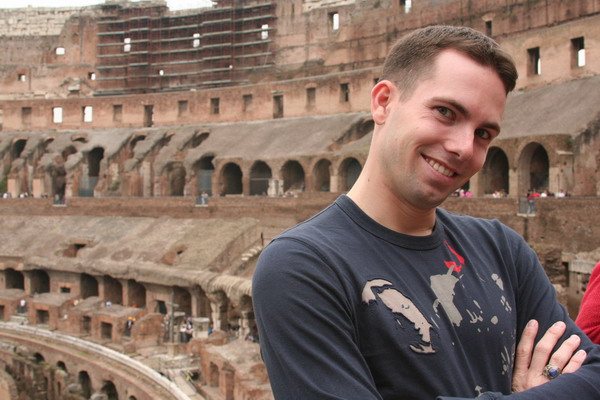
That evening, we explored several of the piazzas. This one is one of the most famous: Piazza Navona.
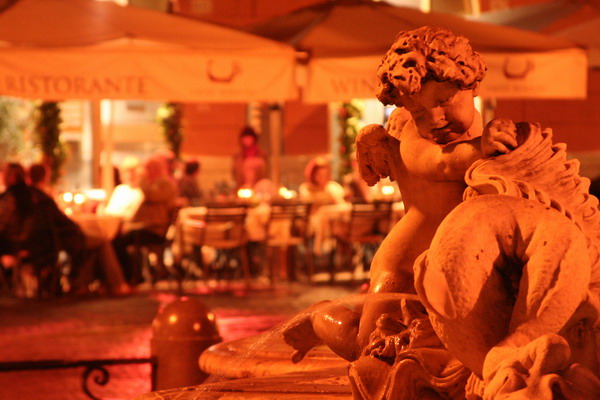
The next morning, we went to a sprawling Sunday market on the left bank of the Tiber River. We began at the Porta Portese and walked for a couple hours, but never actually reached the end. We had read it was the grandfather of flea markets, and it certainly was huge.
Next, we headed out to the outskirts of Rome to see an ancient road that connected Rome to the sea. It was designed to carry foot traffic on the sides and animal powered vehicles in the center. Here are some pictures of animal powered traffic.
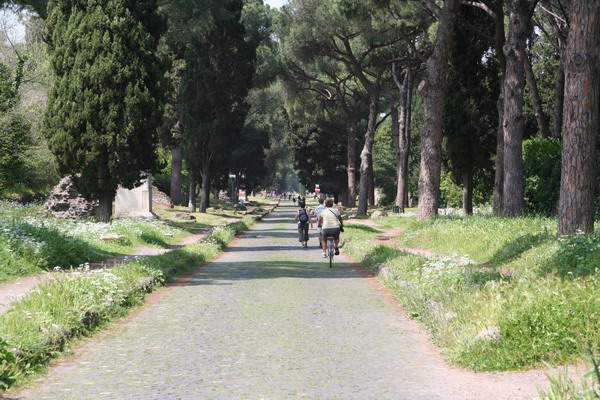
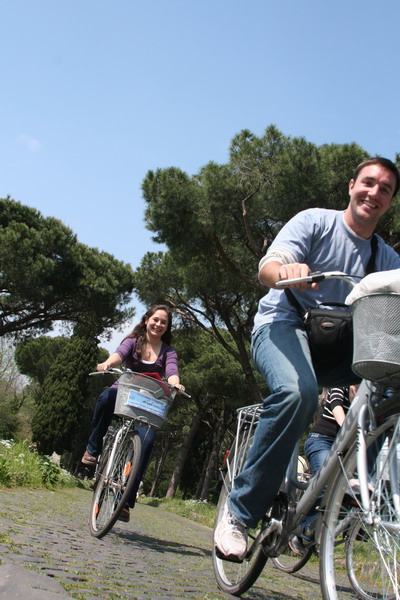
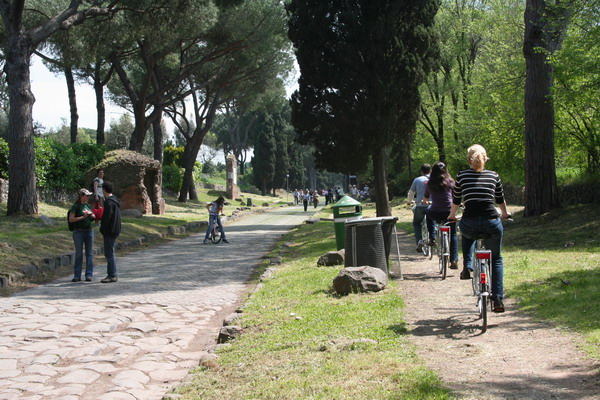
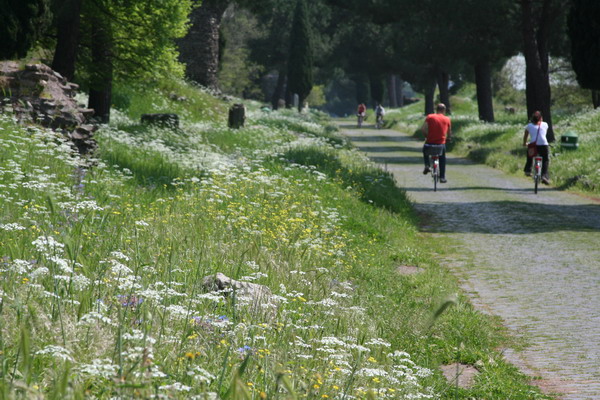
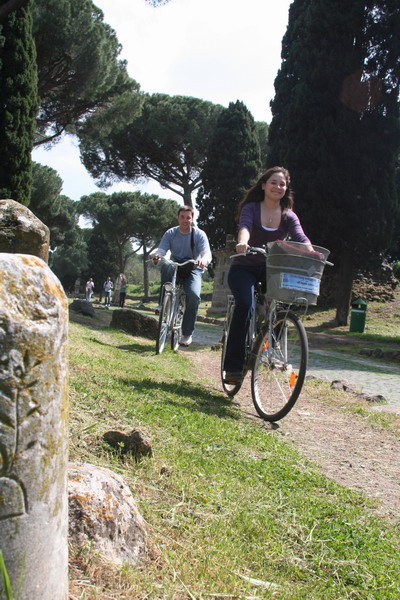
Our last afternoon was spent pursuing several fascinating museums. The first one is the National Museum of Rome.
As you can see they have a Roman copy of the famous Greek discus thrower by Myron.
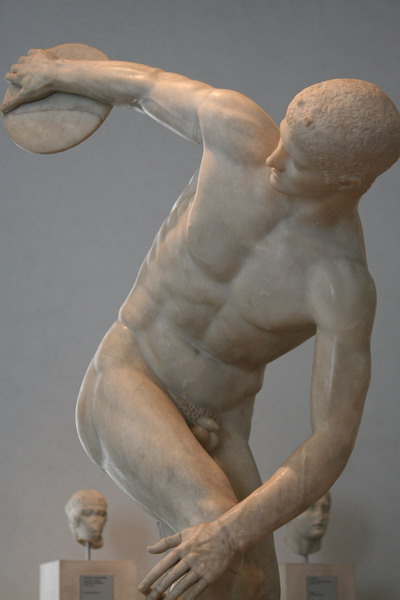
And the busts of the Caesars.

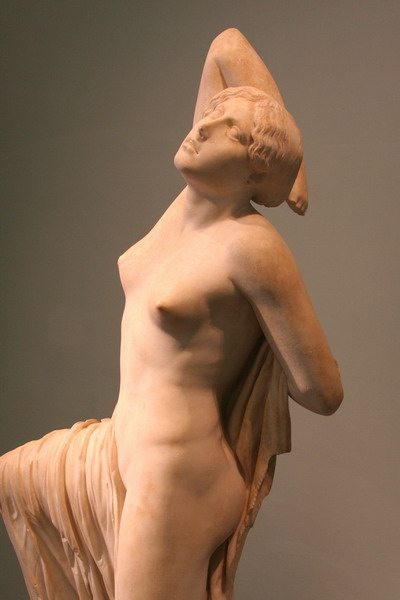
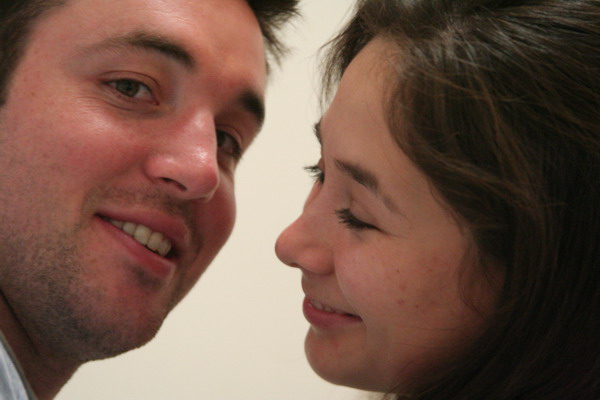
The final museum was the Borghese Gallery. Unfortunately, cameras were again not allowed inside. However, inside, it was a very pleasing blend of art in building, decorating, painting and sculpture.
Here is the outside of one of our new favorite art museums.
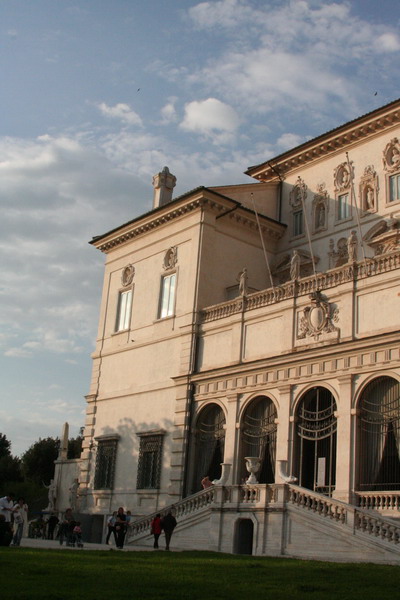
I have to add this quick addendum: for nearly a day, my batteries died. So, Jen was kind enough to let me use her camera. When I look through those images, I may add more to this post (or create another one). So, keep checking back.
Well, that concludes our experience in Rome. It was an outstanding trip and has showed us that Rome is one of our top 5 favorites cities in the world.
We have another trip planned next week to Switzerland. So, I should have some more images to share with you all soon. For those who don’t know, it looks like I will be gone for a while starting next month. So, my postings will either slow down (not that I post that often), or stop for a while. So, we will have to make this next trip memorable.
Until then…
–Jim
Rome — Center of the ancient world
This past weekend we visited the amazing and ancient city of Rome with our friends Jen and Andy. If you enjoy history, this city is rife with it (and consequently this post as well).
The history of Rome is incredibly long and storied. I won’t belabor you with a long history of the city, but suffice it to say it’s interesting.
We began our (all too brief) three day tour with a stop by the rather macabre display called the Cappucin Crypt. It is a rather artful display of the bones of about 4,000 monks of the Cappucin order. Other than being the namesake for Cappuccino, these monks from the mid-16th century up till 1870 chose to have their remains placed on display.
The heading takes a somewhat less spiritual approach: “You are what we were; You will be what we are.” Rather poignant.
Next, it was on to the happier and better known, Spanish Steps, also known as Piazza di Spagna. It’s so named for the Spanish Embassy that was next to the Piazza.
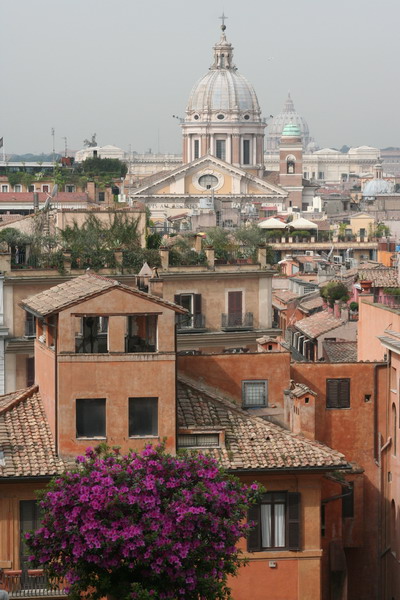
There are 138 steps leading up, away from the house where the English poet John Keats lived in the early 19th century. Anna caught me making a picture of Jen and Andy here.
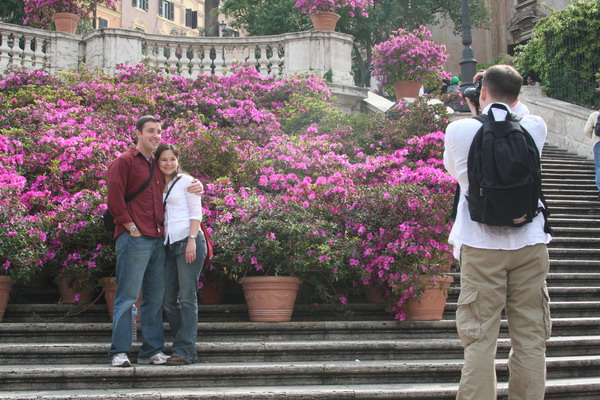
Do you know what the smallest country in the world is? Sizing up at a whopping 100 acres, is the Vatican City, with it’s paltry 980 residents. However, for many centuries, this small city state was the seat of power for the western world. Also known as the Holy See, the Vatican was granted autonomy through the Lateran Treaty, which was signed by the Vatican, the Italian king, as well as the fascist Prime Minister and de facto dictator, Benito Mussolini. Today, the Holy See is a full, but non-voting member of the United Nations and has pledged permanent neutrality in political affairs.
Since there about 54 galleries in the Vatican Museum (including the Sistine Chapel), we decided a tour guide was in order. Plus, with average of 15,000 visitors per day someone to lead us through the chaos was certainly appreciated. Here is our guide who also happened to be from Michigan.
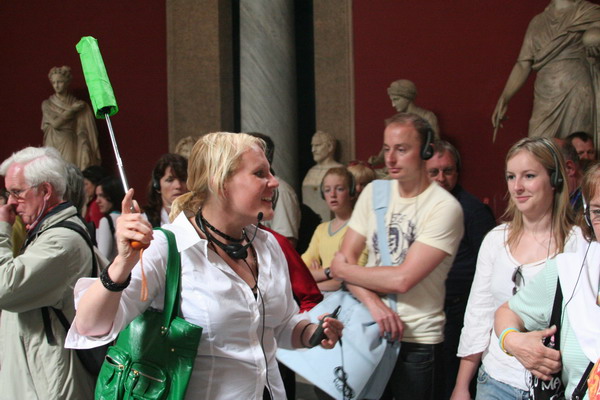
As we traversed the museums, there were exquisite paintings and sculptures that have been accumulated over the museum’s 500 year history (although only 236 years have been as an official museum, but the 500th anniversary was celebrated in October 2006).
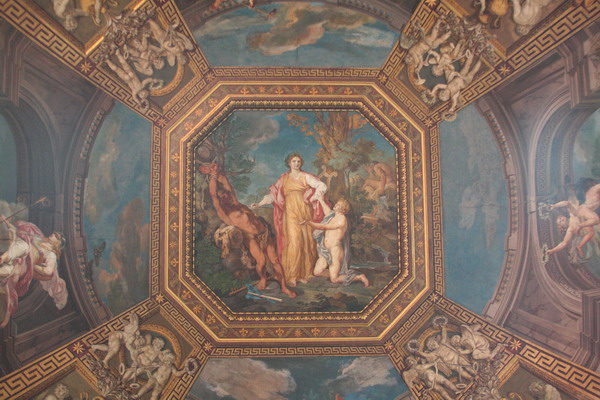
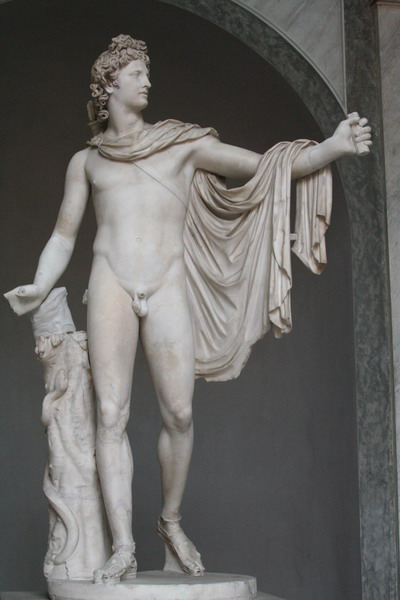
Some of the sculpture had crystal eyes, which added a startling amount of realism.
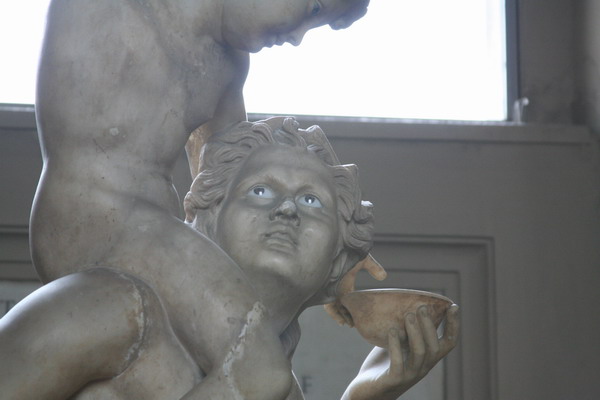
These tapestries were woven by some of the same Dutch masters we saw in Belgium.
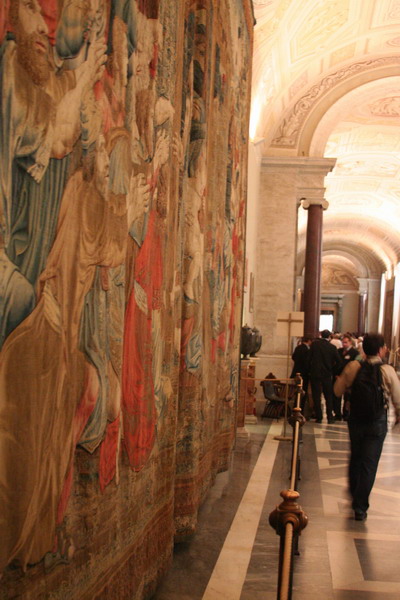
This room is known as the Gallery of Maps (also a nice perspective on the volume of people who pass through the galleries).
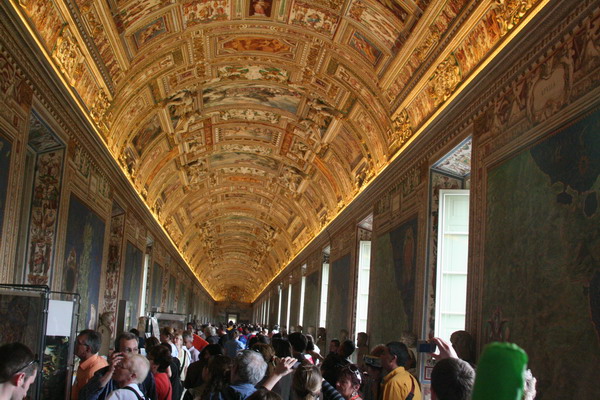
The final stop through the museum was the amazing Sistine Chapel. Functionally, this is where the papal conclave is held to elect a new pope. The current procedure to do that was established in 1274. In April 2005, Joseph Ratzinger was elected Pope Benedict XVI, by a group of cardinals in this room. In the corner, there is a small furnace where the secret ballots are burned. This is how the outside world knows when a new pope has been elected. If the smoke burns black, there must be another vote. If it is white, a new pope has been chosen by a majority vote. Interestingly, since the year 533, a pope also chooses his papal name. Pope John II was originally Mercurius, but since Mercury was also a messenger of the Roman gods, he decided it would be inappropriate to keep that name. However, it is not required to change your name, but the last pope to rule under his birth name was Pope Marcellus II in 1555.
Aesthetically, although I was familiar with the masterpiece ceiling and frescoes of Michelangelo Buonarroti, I didn’t really know the history of it, nor did I truly appreciate the scope in my mind. Although Michelangelo believed himself to be a better sculptor, he accepted a commission from Pope Julius II to paint the ceiling, which he did over four years from 1508 – 1512. Then, later from 1535 – 1541 he was commissioned by Pope Paul III to paint the Last Judgment over the alter. Perhaps the most famous part of the ceiling is the panel in which God is depicted creating Adam with his outstretched finger. Unfortunately, pictures were not allowed in the chapel (although that didn’t stop all too many tourists from snapping away). So, I don’t have any images to share with you. However, it was awe inspiring just to stand in that magnificent room.
Next, we moved out of the museum and into the largest and most impressive church in the world, St. Peter’s Basilica. It stands on the site where Saint Peter was laid to rest in 64 AD. A small shrine was built on the site. When Constantine made Christianity the state religion of Rome, he built a church on the same site. Then, in the mid 15th century when Pope Nicolas V decided to create the largest and grandest church in the world. However, it wasn’t until 1506 that it was officially begun by Pope Julius II, then not until 1626 was it finally completed. To further the idea that Michelangelo was a true Renaissance Man, he aided in the design and was the chief architect for the final 18 years of his life. Unfortunately, he never saw his design come to fruition.
With that, let us enter this grand edifice.
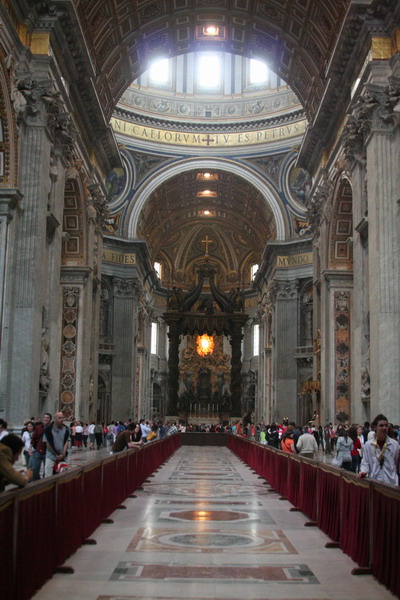
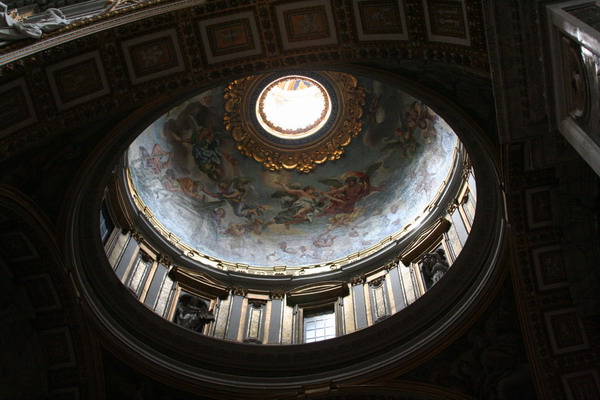
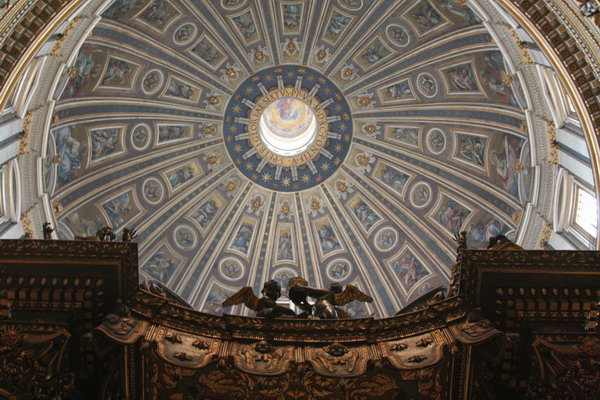
Here is the alter of St. Peter’s.
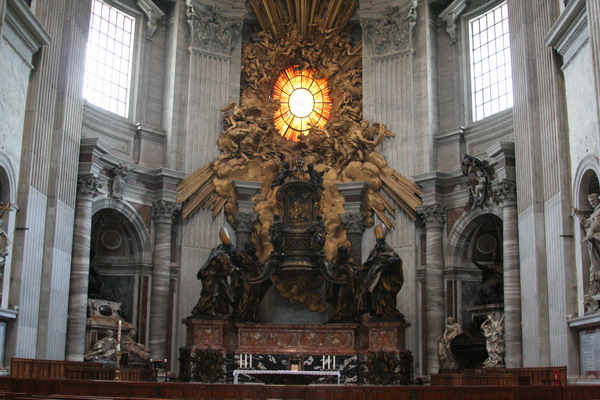
When Michelangelo was only 24 years old (in 1499), he carved the Pietà of a youthful Mary holding a crucified Jesus.
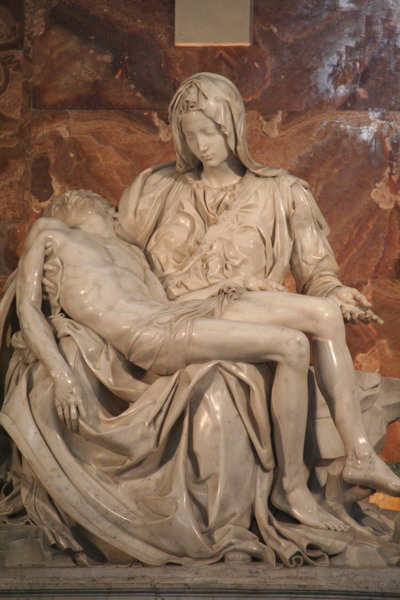
There is also a large statue of St Peter. This statue predates the current basilica and was in the first church.
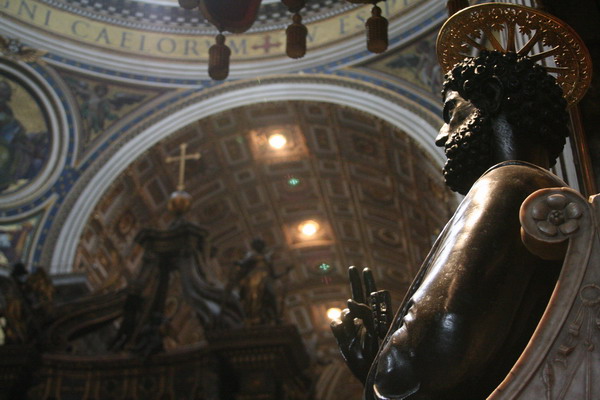
As you can see, people enjoy touching his feet.
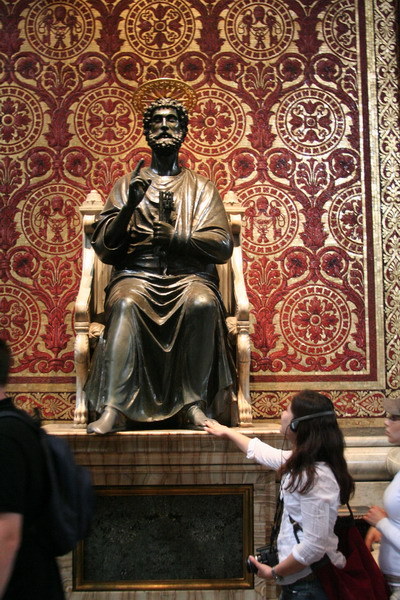
His right foot is so well worn, that the toes aren’t even visible anymore.

There was also a unique statue of Mary holding the shroud of Jesus with his likeness on it.
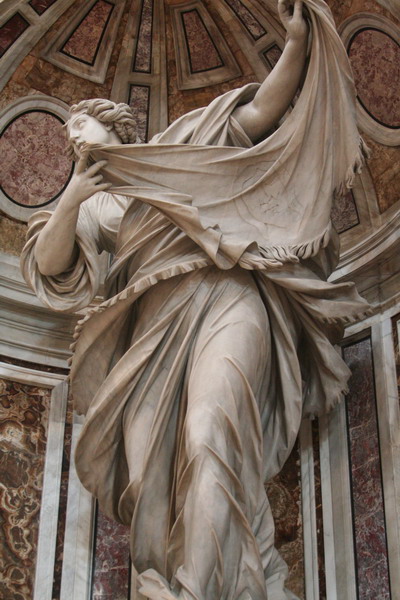
Next, we took a journey up the 323 stairs to the top of the dome.
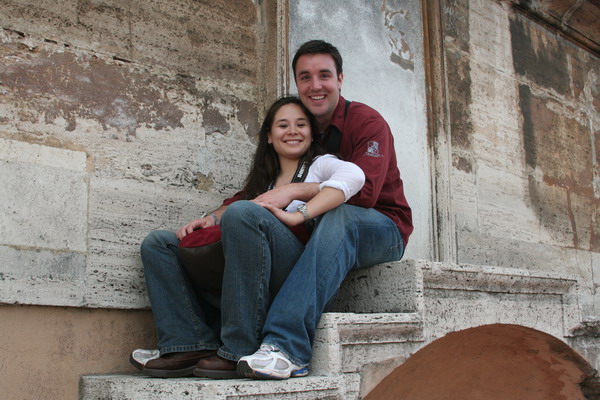
You can see that the dome has a double wall. Since the shape is parabolic, as we climbed higher, the walls curved steeper to the peak. It gave an interesting feeling as we went higher.
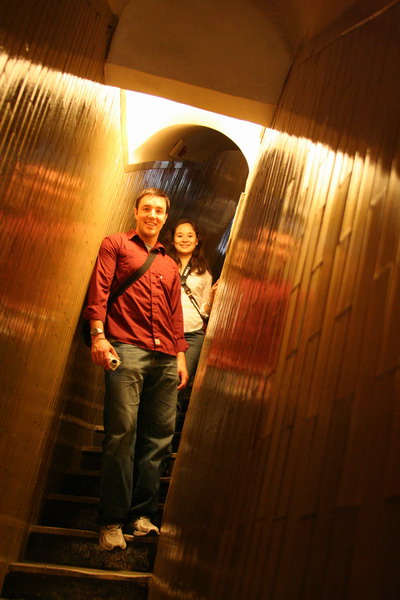
The view from the top afforded a great perspective of the Roman skyline. Here you can see Bernini’s St. Peter’s Square.
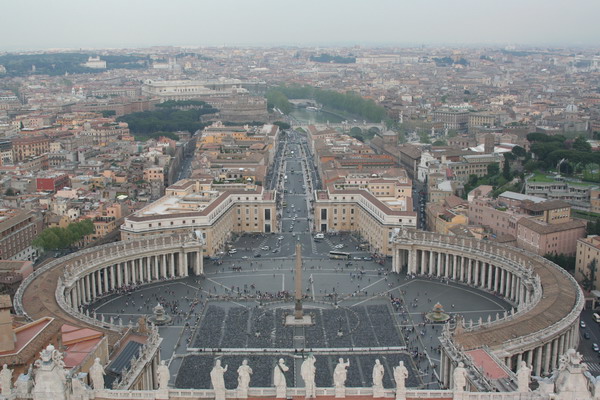
As we exited the church, we saw some of the Swiss guards who have protected the Holy See for the last 500 years. Their uniforms were purported to be designed by Michelangelo…
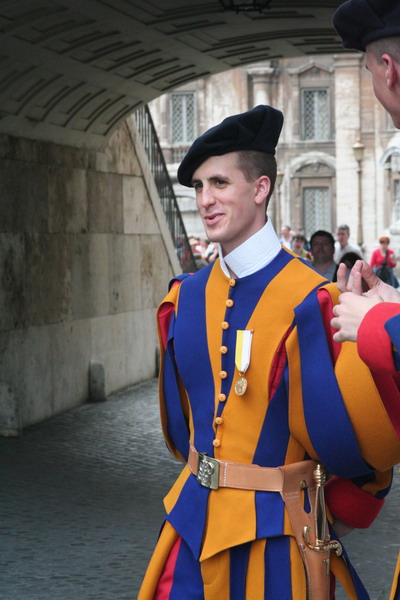
Then, back down in the square, we looked back up to see the square and Dome of St. Peters.
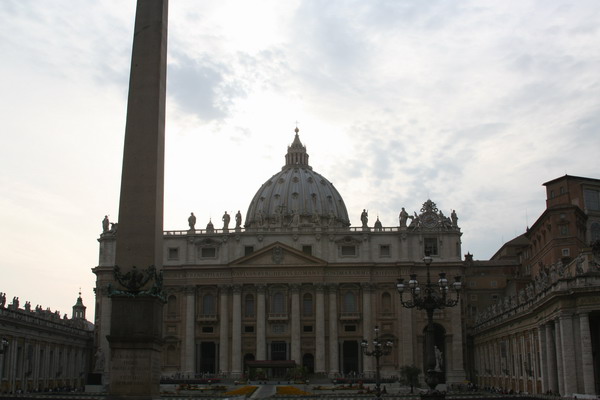
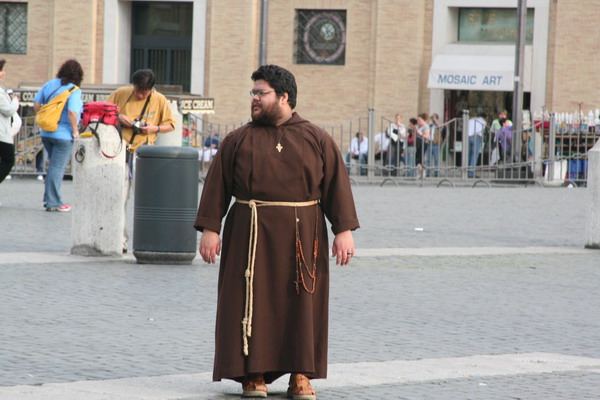
Dinner at the outdoor cafe was perfect.
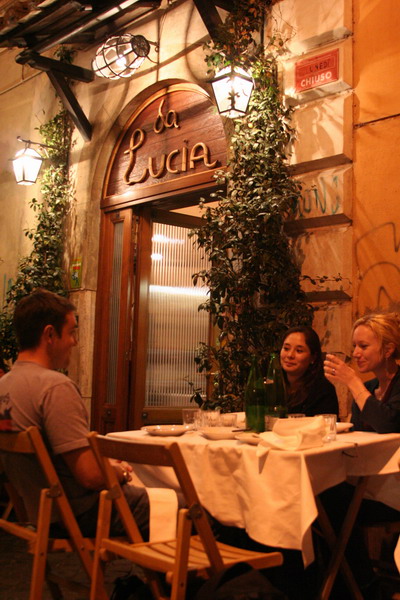
Then, over to the famous Trevi Fountain. It was complete in 1762 and is powered solely by the aqueduct it taps into (with no pumps to aid its flow).
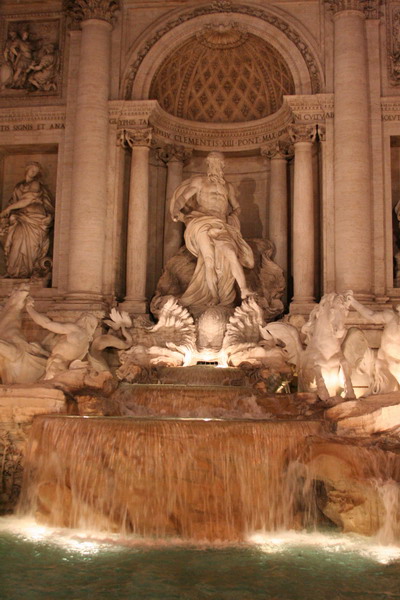
There were plenty of other people there to enjoy it with us.
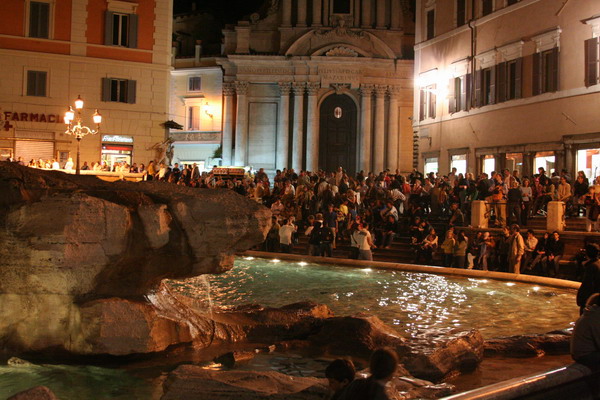
Including Jen and Andy.
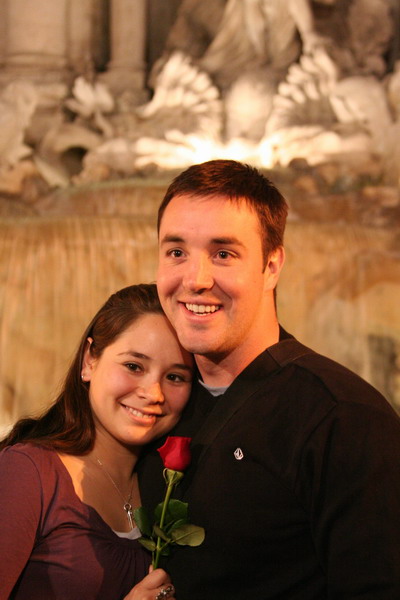
So, that concluded our first day in Roma. The next two were similarly spectacular and filled with historical discovery.
So, until then…
–Jim
The Netherlands in Bloom
***This post is a little large (~4MB). If you can’t load it right away, just refresh the page and it should work the second time…***
The Netherlands in the spring is truly a sight to behold. The countryside is awash in colors. In particular the small town of Lisse has the spectacular park of Keukenhof. Supposedly, it’s the world’s largest flower garden. With 700,000 visitors during its 2 month season, many people agree that it’s worth a visit.
However, the fields of the village have seemingly endless rows of flowers as well. Here are a few of my favorites of the village.
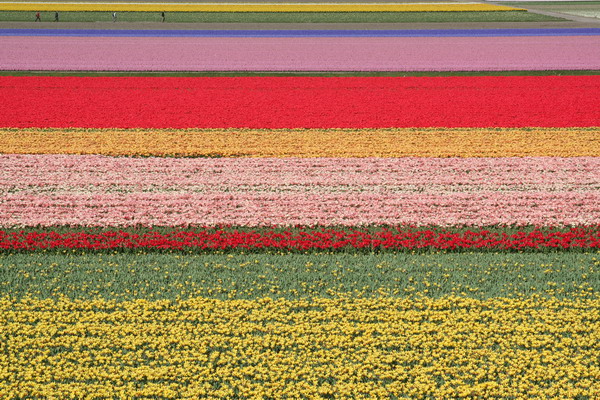
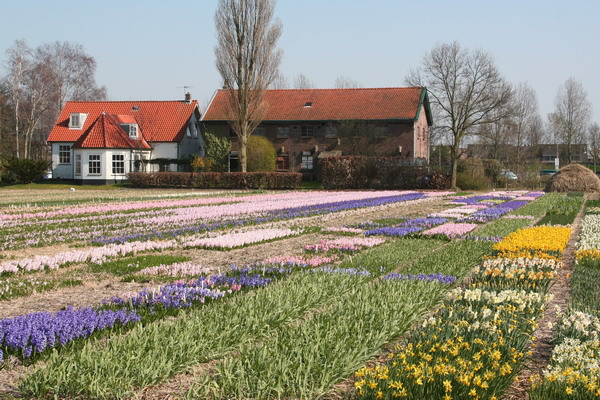
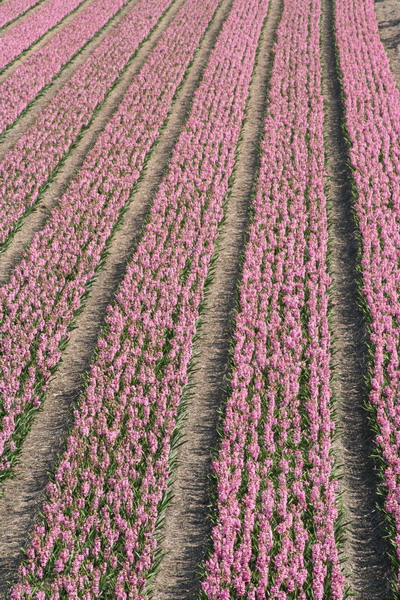
Here are some of the images from our tour of this lovely garden. I won’t belabor the images with a lot of commentary, I will let the pictures speak for themselves.
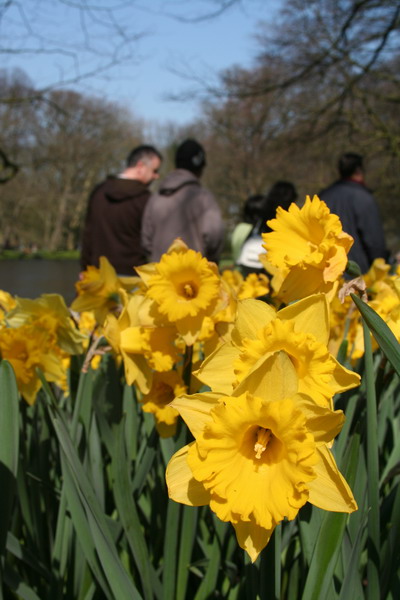
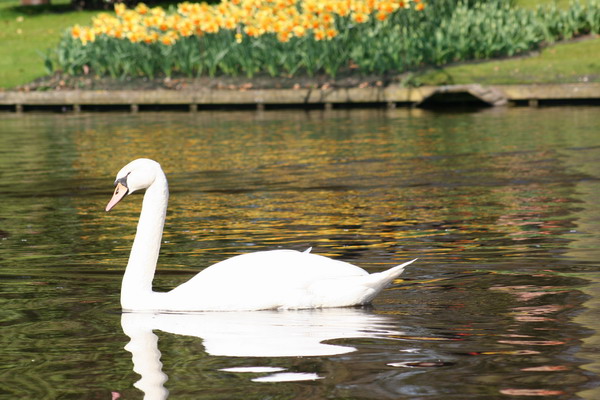


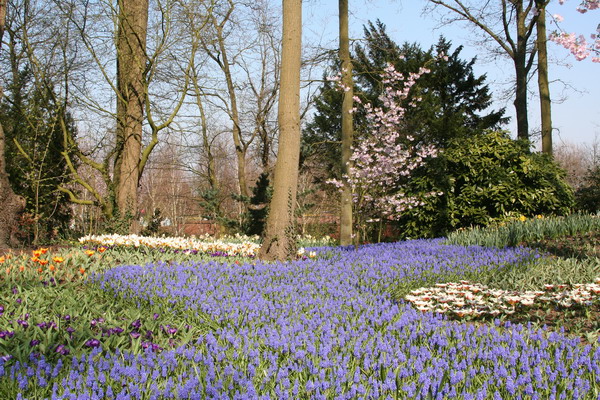
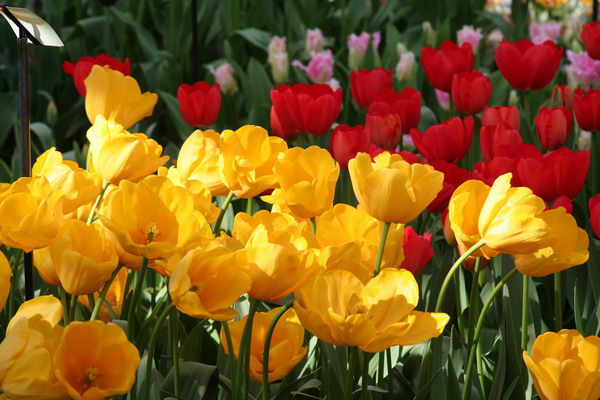
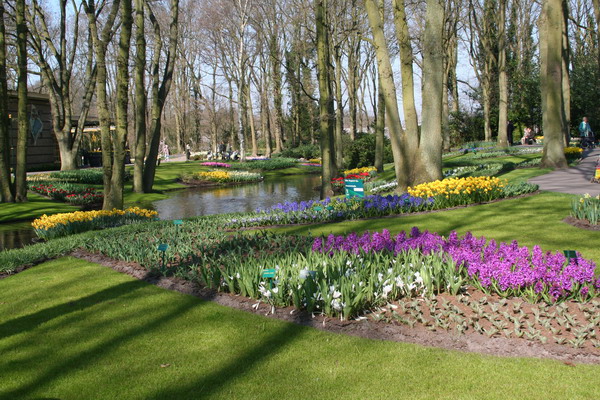
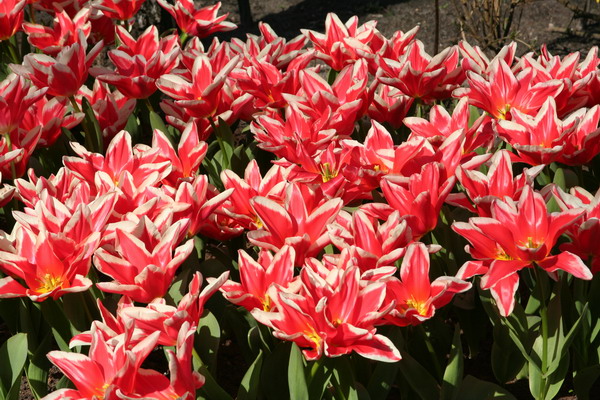
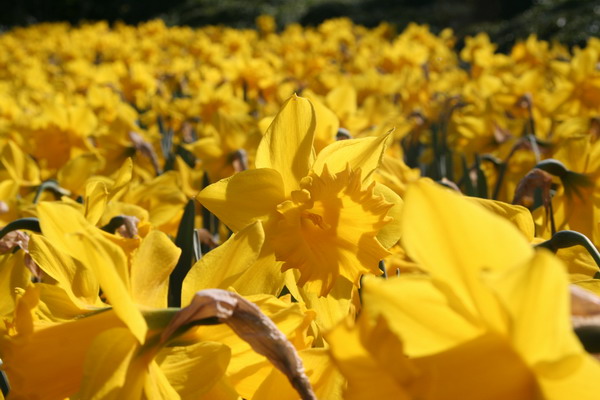
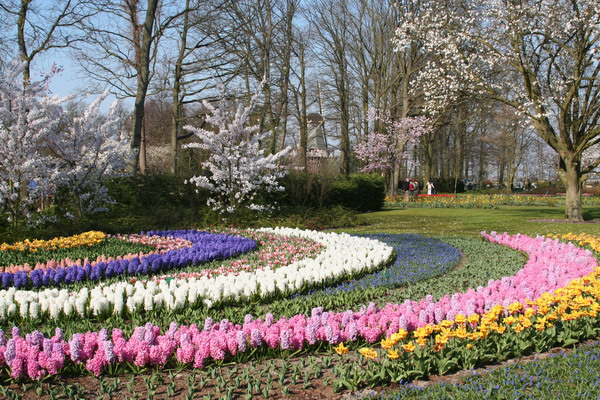
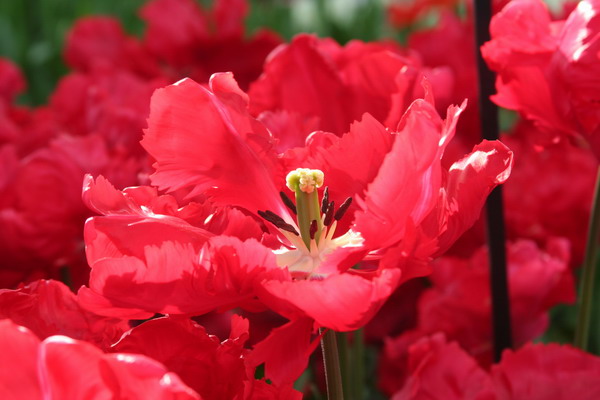
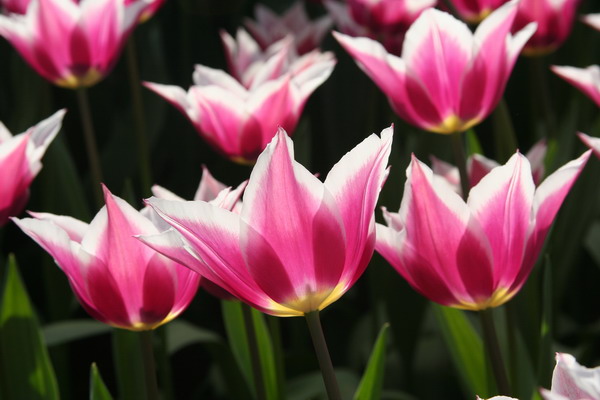
I love that Anna stops to smell the flowers…
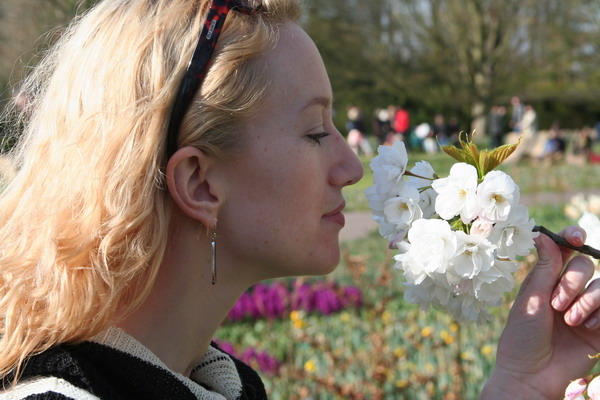
This fat bumblebee doesn’t look like he should fly. He has had a bit too much pollen today.
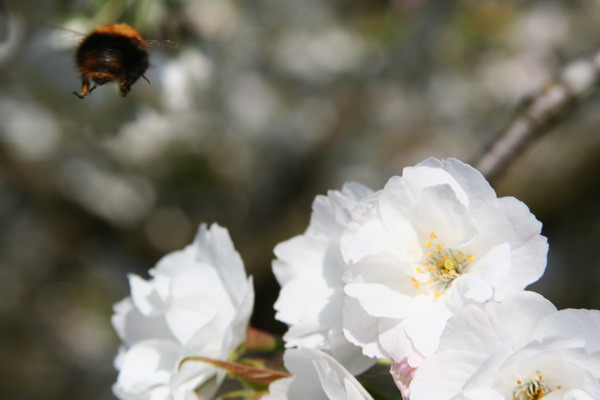
These are our friends, Andras and Elvi. They have a really unique story: he is Hungarian, she is Israeli and they are married and live in Luxembourg, but are moving to Belgium. We randomly met them in a Luxembourg cafe after watching a movie. We started chatting and hit it off right away. So, we decided to meet up in the Netherlands to check out the flowers for a weekend.
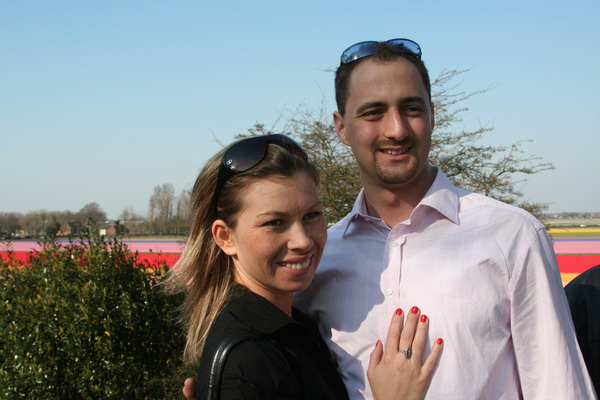
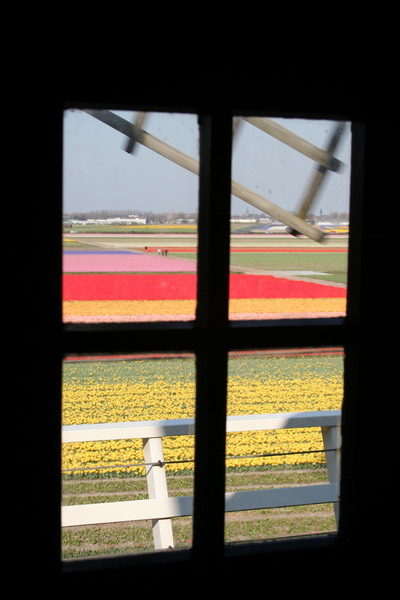
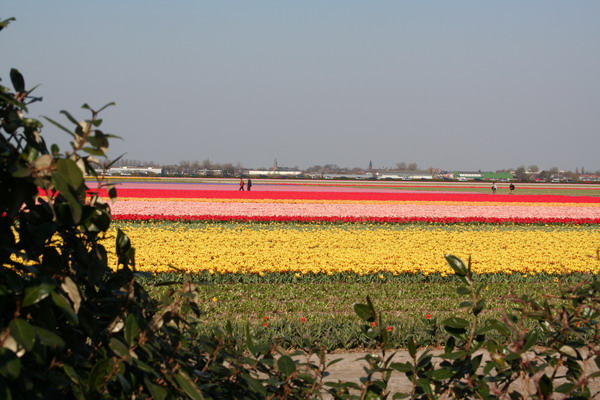
Here’s another good idea for other parks out there. Put a nice comfy couch and people will just hang out…
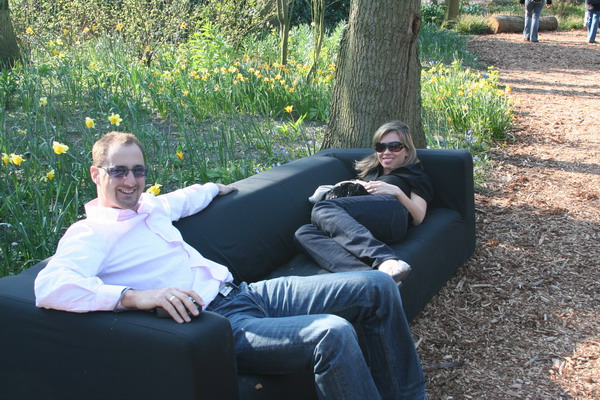
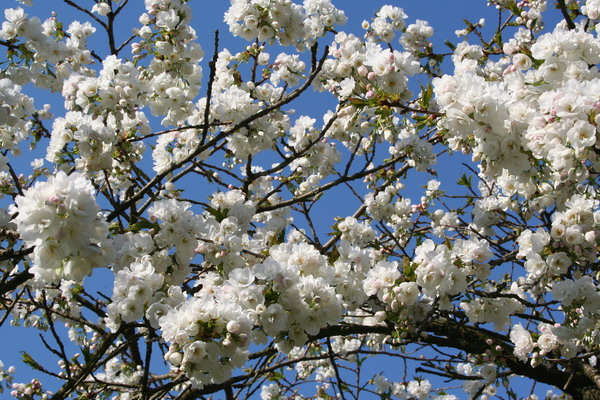
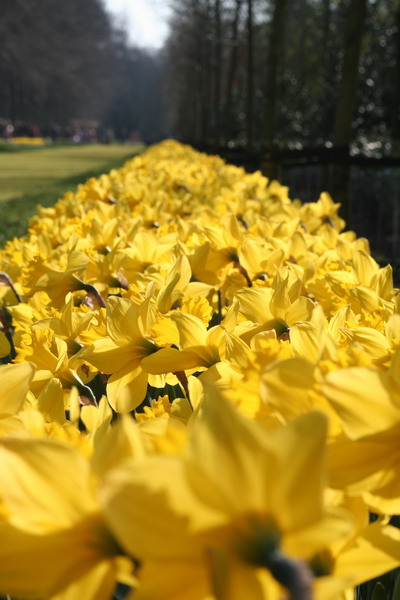
The other really cool activity we did in Amsterdam was rent bikes. It is THE mode of transportation. It’s so convenient to hop on a bicycle, use one of the ubiquitous bike lanes and you can get from one side of the city center to the other in about 15 minutes.
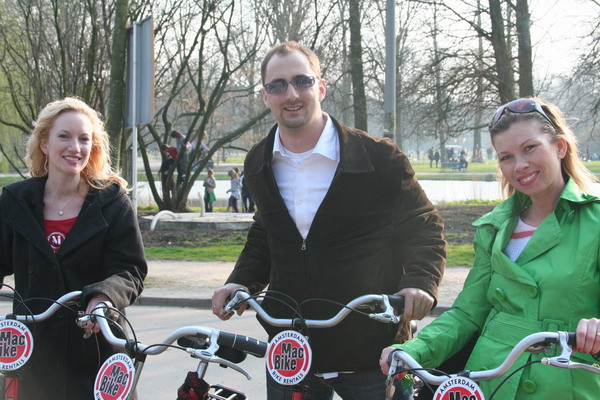
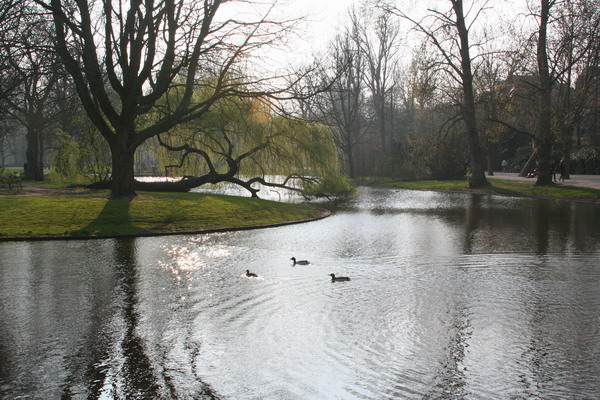
The people watching was lots of fun…
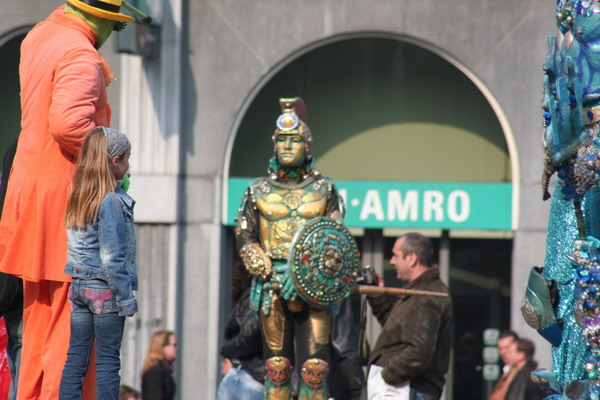
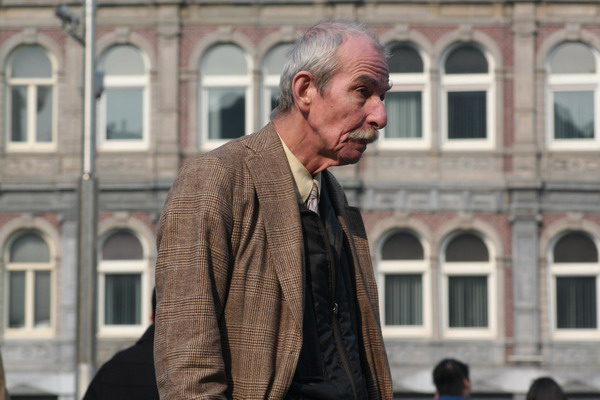
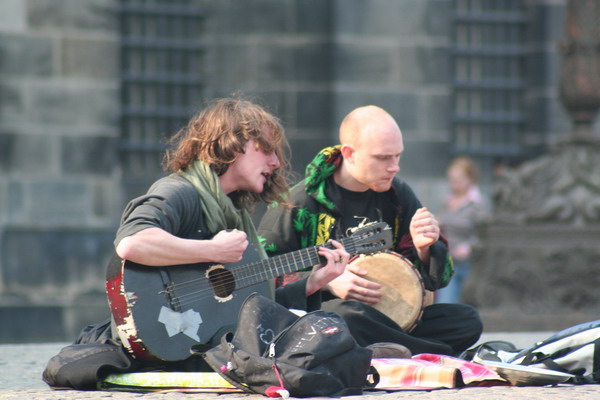
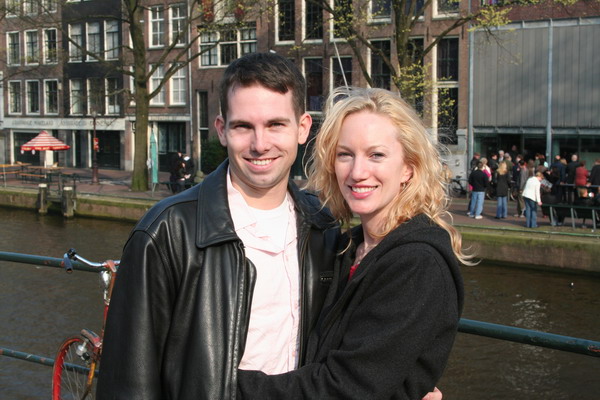
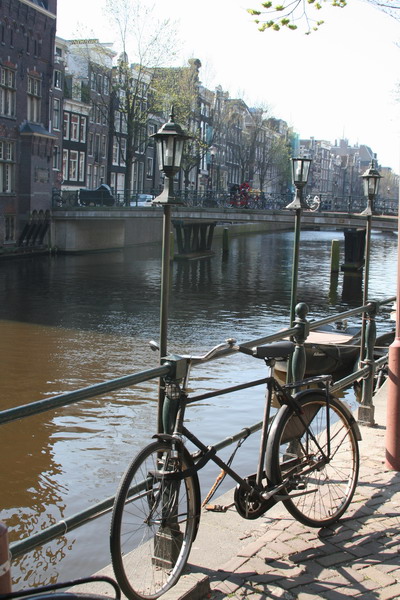
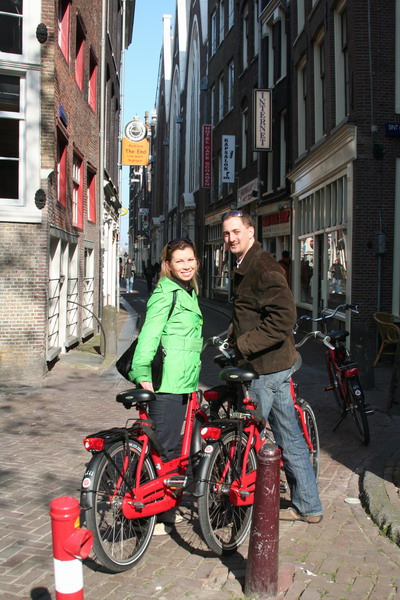
The cafes were also lots of fun.
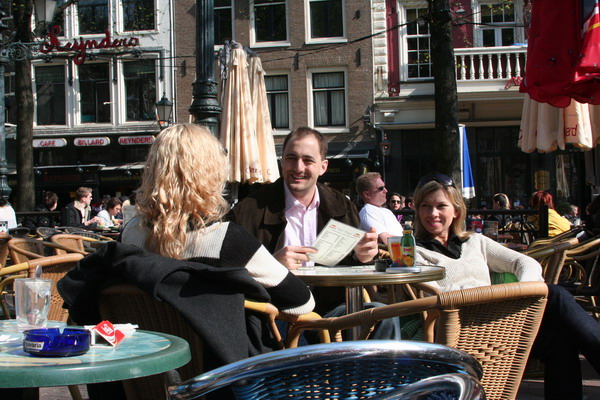
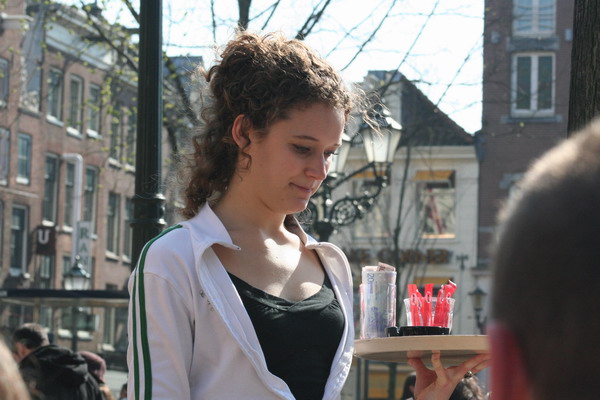
This cool puppy was actually wearing his shades (not just for the picture). He and his owner had matching glasses.
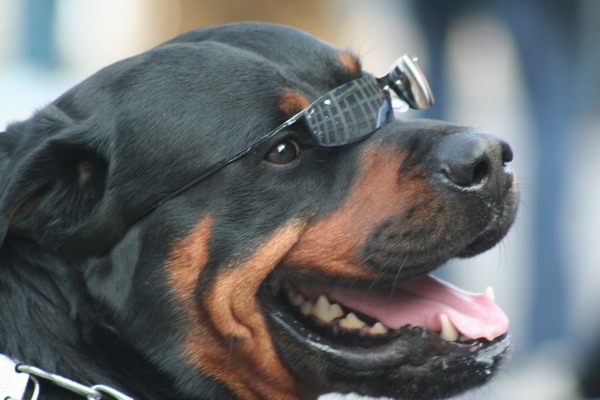
Amsterdam is a city that has so much going on. We could have stayed for 2 weeks and not run out of things to do. I think this may be our favorite spring destination. For me, it’s on my top five list of favorite cities in the world. We can’t wait to go back again soon!
Until then…
–Jim
Luxembourg and Belgium–Family visit part three
This is the final post of the whirlwind tour my parents, Anna and I took last week.
In this post, we will go to the American military cemetery in Luxembourg followed by a tour of the forests around Bastogne to see the sight of the Battle of the Bulge. Finally, we finished the tour with a visit to the picturesque village of Bruges, Belgium and a short stop by the North Sea.
We started with a visit to an American military cemetery. It is one of 24 American overseas cemeteries that are the final resting places for 124,913 Americans killed in warfare (WWI, WWII and the Mexican War). This particular one is just outside of Luxembourg City. It is just over 50 acres and serves as the final resting place for 5,076 soldiers, sailors, marines and airmen and was established on 29 Dec 1944, while the Battle of the Bulge raged nearby.
It is interesting to note that the land for all the cemeteries has been given back to the US. All these military members are buried in American soil. Also, this location was the headquarters of General George S. Patton Jr’s Third Army. In fact, the General is also buried here. Although he was killed in a vehicle accident shortly after the war’s end, he is buried in a place of honor with the many other members of the third army. Here he is…
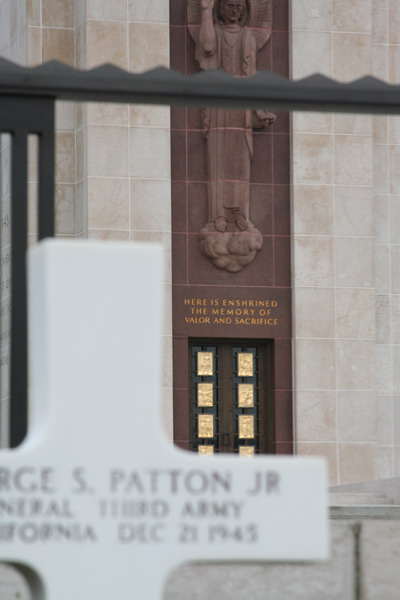
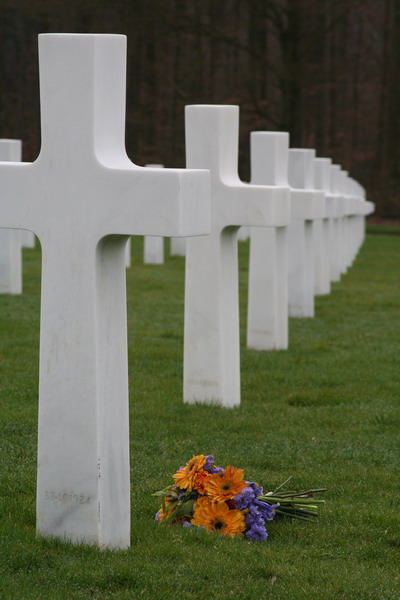
There are number of these poignant reminders of the horror of war scattered through the cemetery.
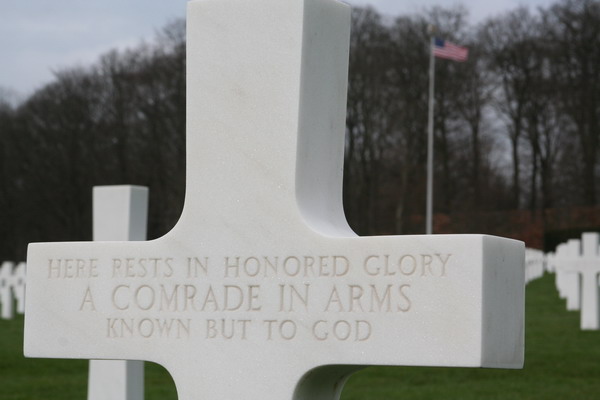
After our tour of the American cemetery, we drove up the road to the center of the Battle of the Bulge. Of you’re not familiar with this battle (and no it’s not a reference to the collective growing American waistline), here’s a brief rundown. On 16 December 1944, the German army on Hitler’s orders made one final push to repel the Allied advance on the west. His belief was to slow the western front would allow him time to build his super weapons (jet planes and super heavy tanks, for example). Initially, the German offensive was very successful and indeed it was the single most costly American engagement of WWII. Over 19,000 Americans lost their lives, however, it was the turning point in the European campaign. It signaled the beginning of the end and although it was a temporary setback for the allied army, it was a decisive blow to the German military machine.
Here in Bastogne, the German cemetery is a very poignant site to see. It is set with trees throughout and each headstone lists six names (three on each side). This is in stark contrast to the one on each American headstone.
After, we traveled to the forests around Foy (a small town outside of Bastogne). This is also the region where Easy Company of “Band of Brothers'” fame fought over Christmas in 1944. It was incredible to actually walk though the forest and see where these men dug in to repel the attacking forces. The 101st Airborne (of which Easy Company was a part) was cut off in the Battle of Bastogne (part of the larger Battle of the Bulge) after the initial battle. In fact, the German Army commander felt he had effectively cut off all options for the Americans in Bastogne. They were outnumbered, with limited ammunition, and little winter clothing. The German commander asked the American commander, Brig Gen McAuliffe, to surrender. The General, in typical American fashion, replied “Nuts!” This didn’t translate very well (in fact, it’s a phrase not used today, but as far as I can tell, it means “you’re crazy”), so his translators just used the term, “Go to hell!” This simple and direct phrase was echoed throughout the regiment and gave the men great strength.
While the trees were probably replanted after the war, this is probably similar to how the area looked when Easy Company dug in to fend off the advancing enemy.
The men of easy company were immortalized in Stephen Ambrose’s novel “Band of Brothers” which was later made into a highly acclaimed HBO mini-series (it won the Emmy for outstanding mini-series). Tom Hanks and Stephen Spielberg co-produced them. Afterward, the Hanks family, HBO and the Jeep corporation donated this monument to the men of Easy Company.
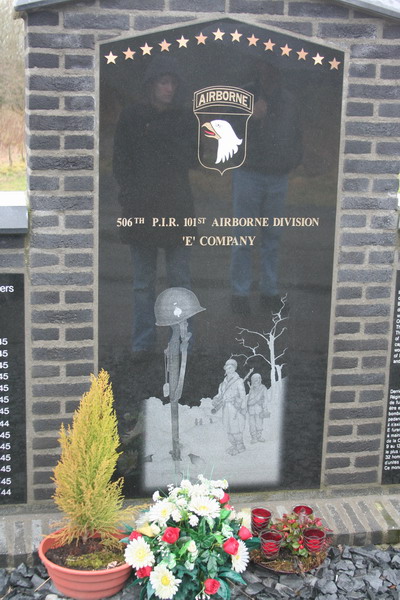
There is also a powerful museum in Bastogne dedicated to the battle.
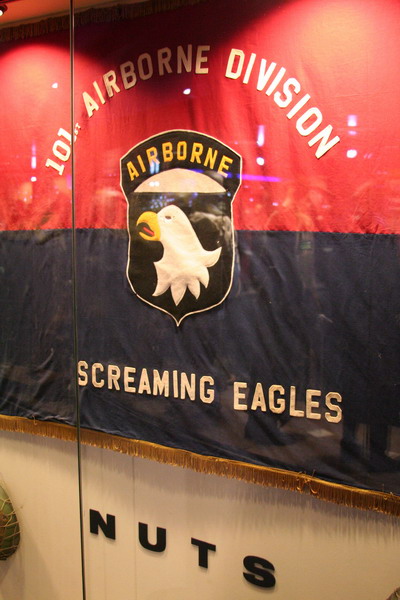
It was a great opportunity to see first hand just what happened over 60 years ago.
Next stop was the beautiful Belgian city of Bruges. This city is a very popular tourist destination (for good reason). Our first sight was the Church of Our Lady that houses a statue carved by the venerable Michaelangelo. This is one of only a few of his statues outside of Italy.
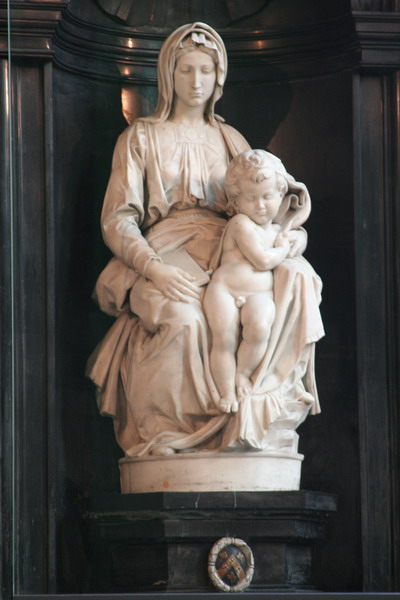
The rest of the church was quite spectacular as well.
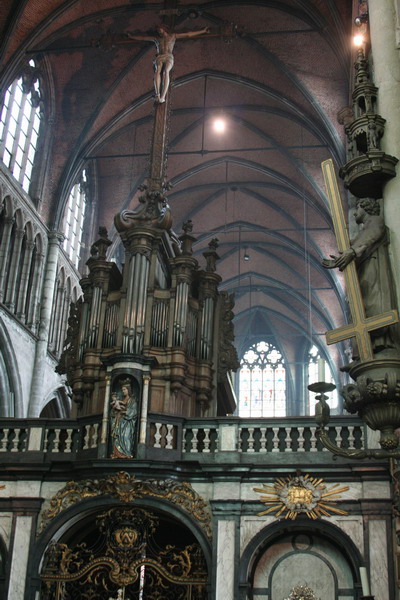
There was a moat that surrounded the medieval city that is visible today.
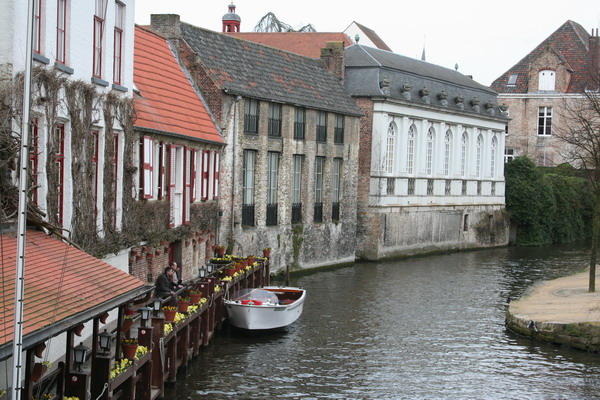
As you can imagine, Belgian waffles originated in Belgium, so they are available pretty much anywhere. However, something that may be interesting is that there are two types of waffles (or gauffres), the “Belgian” with it’s rectangular shape associated with Brussels and the Liege version (associated with that city). You can see here the Liege version with thick dough and irregular shape. These are not eaten for breakfast, but as a snack through the day and not with utensils (it’s finger food).
The famous bell tower afforded a great view of the city.
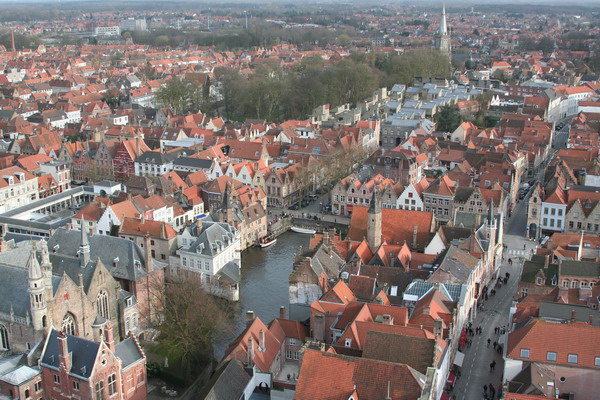
The other Belgian delicacy is of course chocolate. There are no shortage of shops that sell truly delicious treats. This particular one came highly recommended and did not disappoint…
Dinner that night was also delicious. My father enjoyed the traditional menu of mussels and fries (which is also originally Belgian) and the rest of us had similarly great meals.
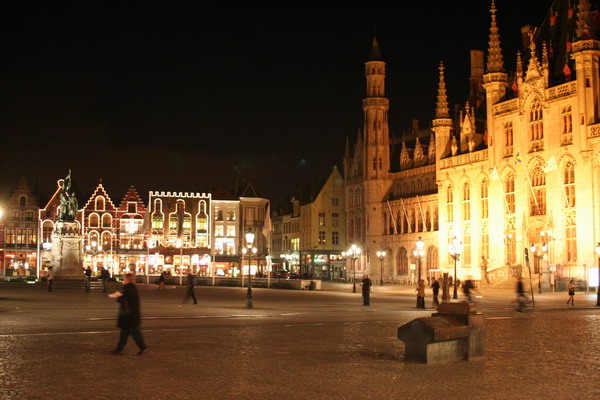
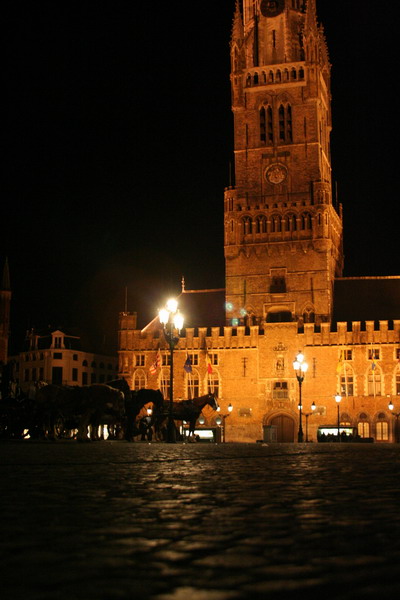
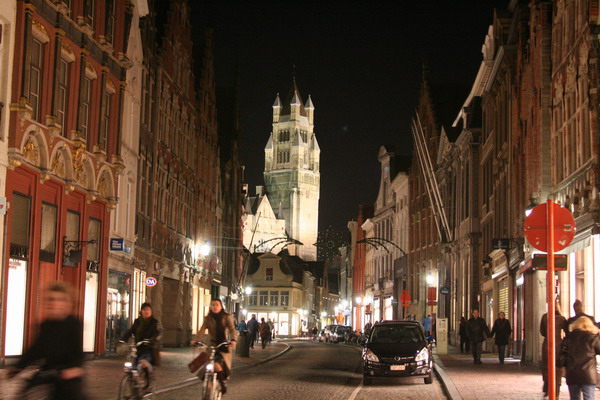
The next and final stop on the Tourist Train was the beach city of Oostende on the North Sea. We had a brief tour and stopped on the beach for a picnic lunch.
Since it was such a nice day and we had come all the way to sea, my mother and I decided to take a quick dip. Unfortunately, I was not dressed for it, but I still had to get in a little ways…
That concluded our whirlwind tour of Bavaria, Austria, Munich, Amsterdam, Luxembourg, and Belgium.
It was a great trip for all of us. 🙂
Until the next trip…
–Jim
Amsterdam–Family visit part two
This is the continuation of our trip through western Europe last week with my parents. In this post, we will travel to Amsterdam, Netherlands for a couple days of exploration.
As you probably are aware, the Netherlands is known for it’s bountiful windmills. This one greeted us on our way into town.
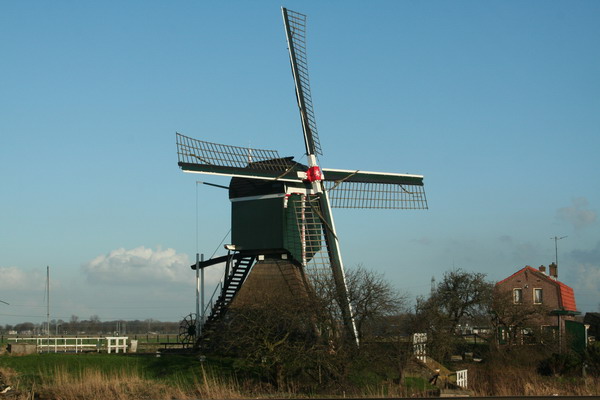
We began our exploration of Amsterdam with a walking tour. It’s a great city to tour by foot, or even better by bicycle. It was the most bicycles I’ve seen since we were in China.
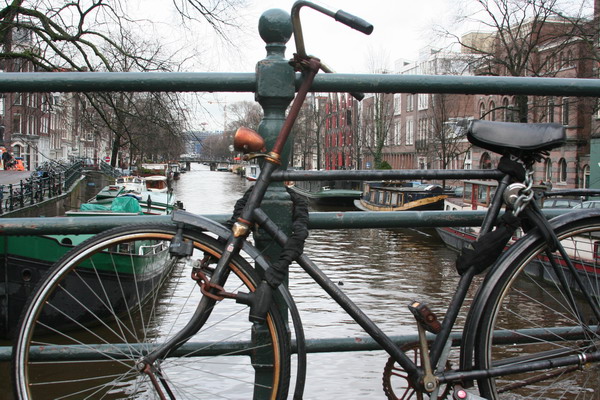
As you probably also know, most of Amsterdam is below sea level and their dikes regulate the water levels so that the canals flow in concentric half circles through the city.
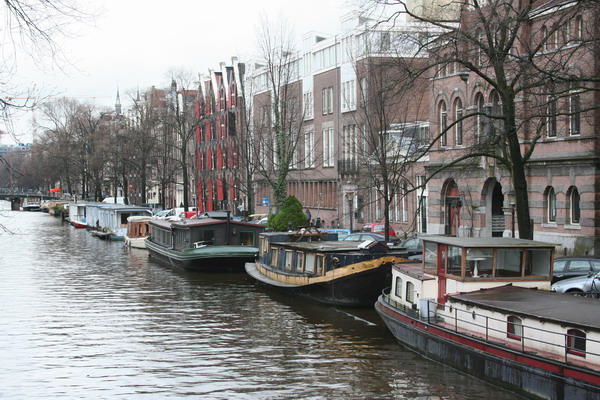
We watched this guy meander across the street.

The Netherlands is also very densely populated. It has about the same population as Florida, but is only about the same size as Maryland. So, suffice it to say that space is an issue. To solve that concern, there are many small vehicles there. Here’s just one example…
Again, let me stress that everyone rides a bike in Amsterdam. In fact, you can see people doing all kinds of interesting things as they ride along. It’s not uncommon at all to watch people talk on their cell phone and ride (how dangerous is that!?). This guy was actually typing an SMS message as he rode and hardly even looking up. Fortunately for him, the bike lanes are very wide…
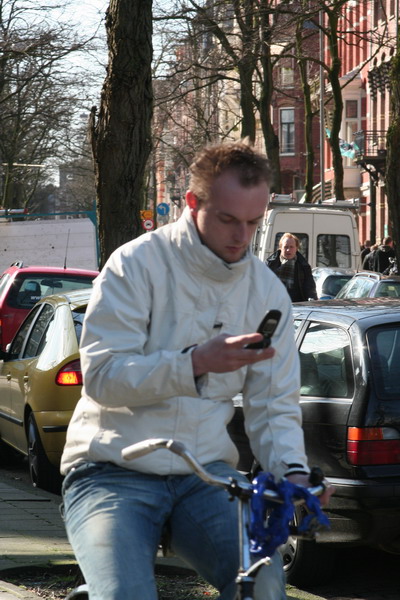
Next stop was the house/warehouse where a young Anne Frank and her family hid for 2 years in WWII (June 12, 1944 – August 1, 1944). It is a poignant memorial to the girl whose diary has been sold 25 million times in over 50 languages and is certainly considered one of the classics of the 20th century. It was her life goal to be a famous, published author. It’s sad it was posthumously achieved. However, she gave a face and story to the untold suffering of the millions caught in the Nazi web of persecution and concentration camps effecting the “final solution.”
Before we visited the secret annex of the Anne (and seven others), we watched the 1959 movie about her struggle that also won the best picture Academy Award.
This is the front side, which is the warehouse where her father owned a spice/preserve company. When the family decided to go into hiding, it was in a carefully guarded secret annex in the back.
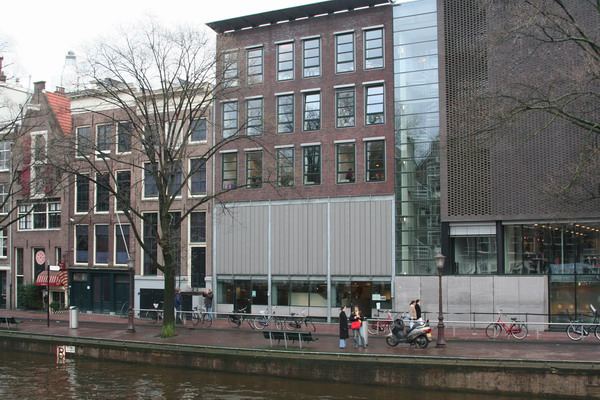
We also visited the Rijksmuseum Art and History museum. If you are a fan of the great Dutch masters like Rembrandt, Vermeer, Frans Hals or Jan Steen, this is the place to go. Unfortunately, pictures are not allowed inside, but the trees were just budding and a work of art themselves.
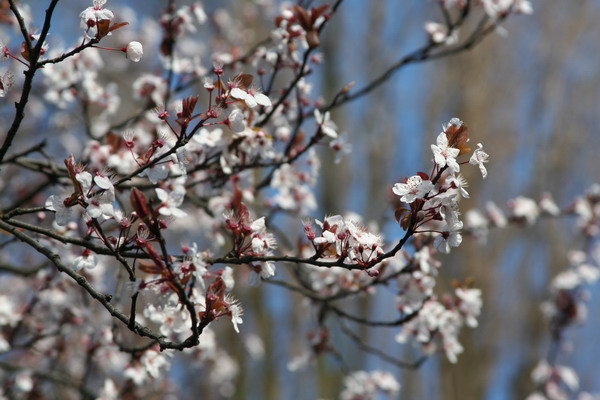
Here are some more of the quintessential Dutch items from the Netherlands:
Wooden shoes
Tulips
Heineken Beer
Windmills
Herring Sandwiches
Of course, there aren’t as many windmills anymore, and wooden shoes are still used as a long lasting work shoe, but these days are used more as a souvenir than practical footwear. That said, the other three are VERY common. We decided to sample a raw herring sandwich…
Yum…
Another fascinating trade often practiced in Amsterdam is diamond cutting and polishing. We toured one company to see how the process works.
This is the diamond being polished.
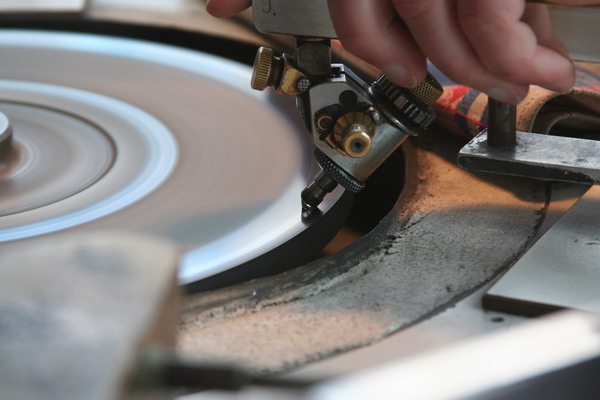
Then, he inspects each facet to ensure perfection.
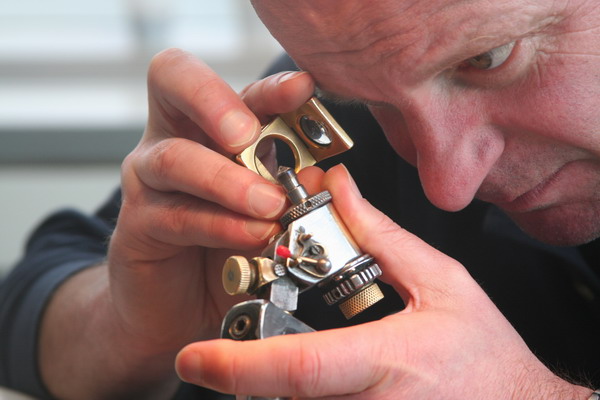
There were also other diamond colors like this black one.
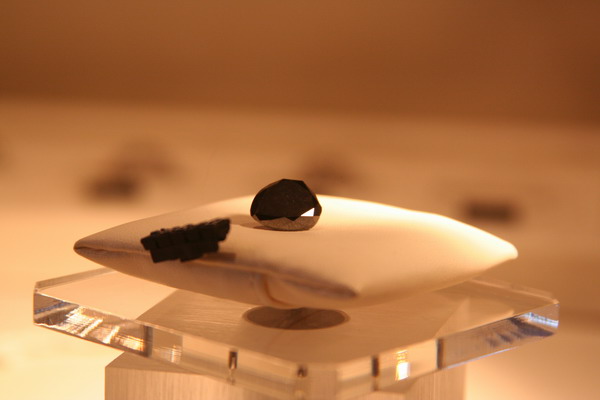
That night, we wandered through another famous part of Amsterdam, the Red Light district. It was a unique experience to wander through areas where the world’s oldest profession is on display legally and openly.
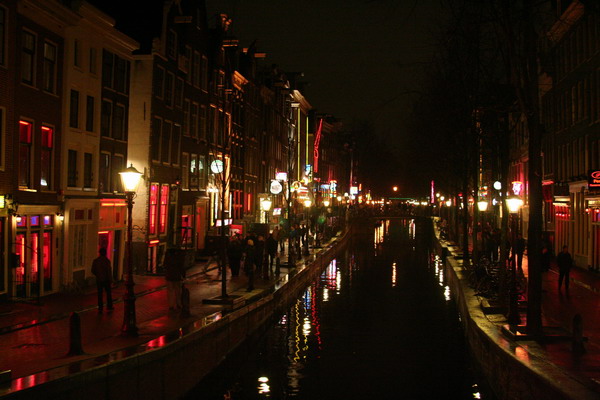
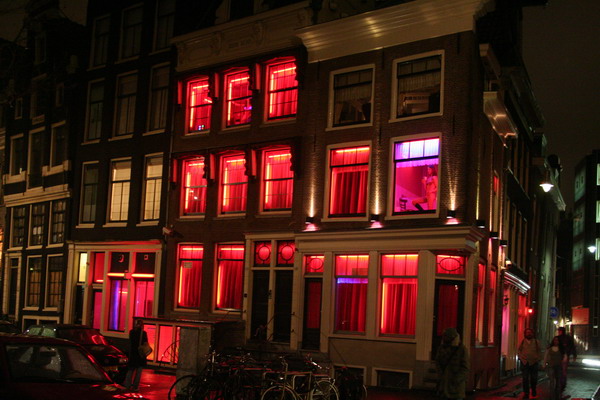
We also took a night cruise to see the canals first hand.
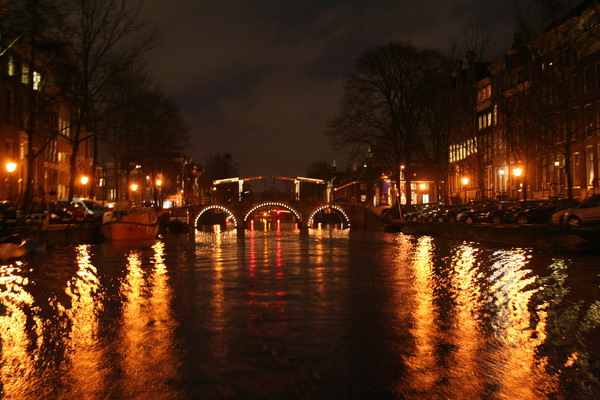
So, that completed our brief tour of the city of Amsterdam. Anna and I look forward to going again soon when the tulips are in bloom. Perhaps I will have some more images to share with you.
The next stops on our tour with my parents were Luxembourg and Belgium.
So, until then…
–Jim
